Financial Accounting 1 Report: Bookkeeping, Statements, and Analysis
VerifiedAdded on 2023/01/10
|21
|4289
|36
Report
AI Summary
This report delves into the core concepts of financial accounting, encompassing two key scenarios. The first scenario examines business transactions, differentiating between internal and external types, and exploring single and double-entry bookkeeping systems. It explains the significance of trial balances and provides practical examples of journal entries, ledger accounts, and trial balances. Furthermore, the report clarifies the distinctions between financial reports and statements, outlining fundamental accounting principles like the monetary unit assumption, going concern, and the matching principle. The second scenario shifts focus to bank reconciliation, detailing the process of aligning company records with bank statements, and explaining control accounts and suspense accounts. The report also includes illustrative examples, such as profit and loss accounts, and balance sheets, thereby offering a comprehensive understanding of financial accounting practices. Finally, it provides an analysis of income statements and balance sheets.
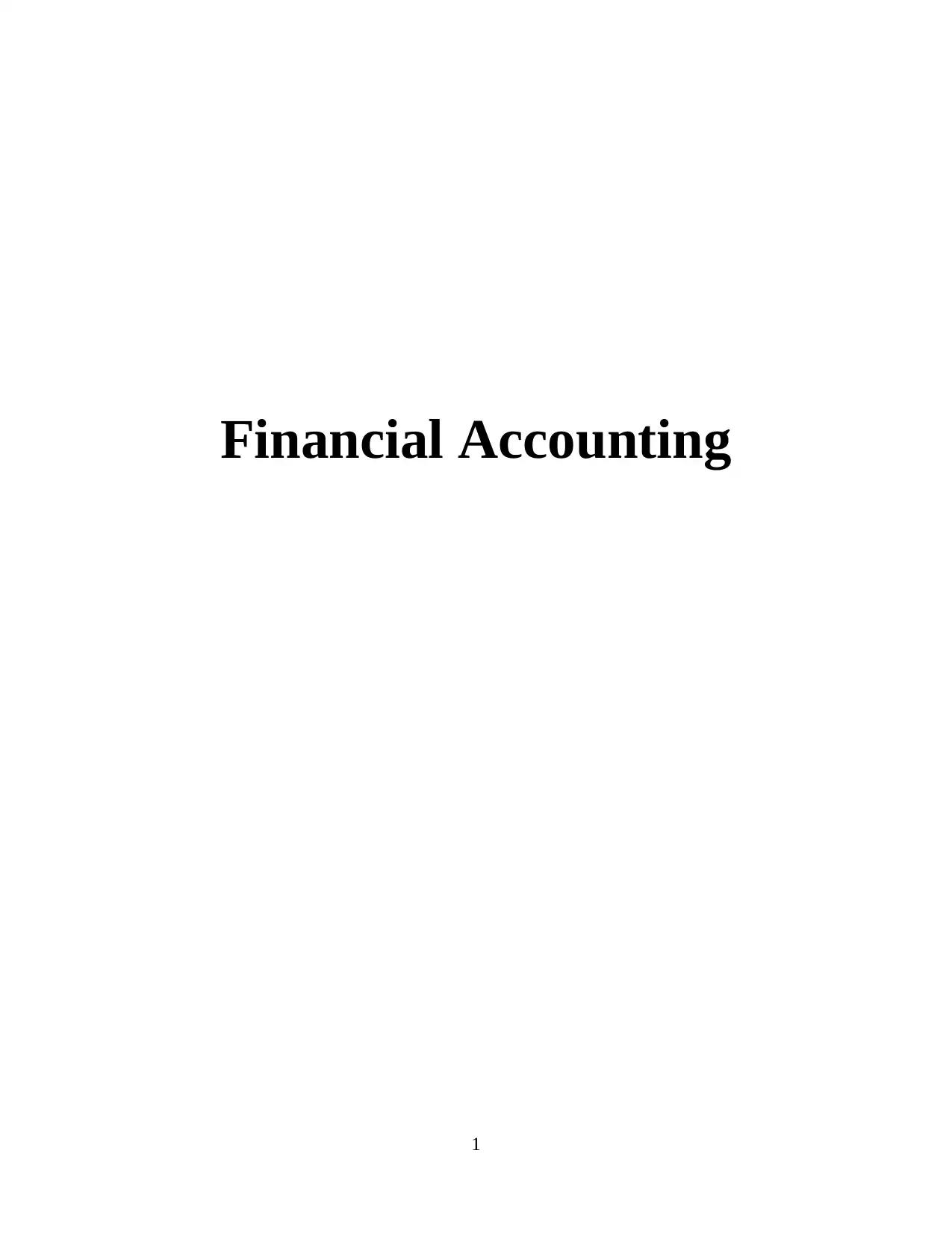
Financial Accounting
1
1
Paraphrase This Document
Need a fresh take? Get an instant paraphrase of this document with our AI Paraphraser
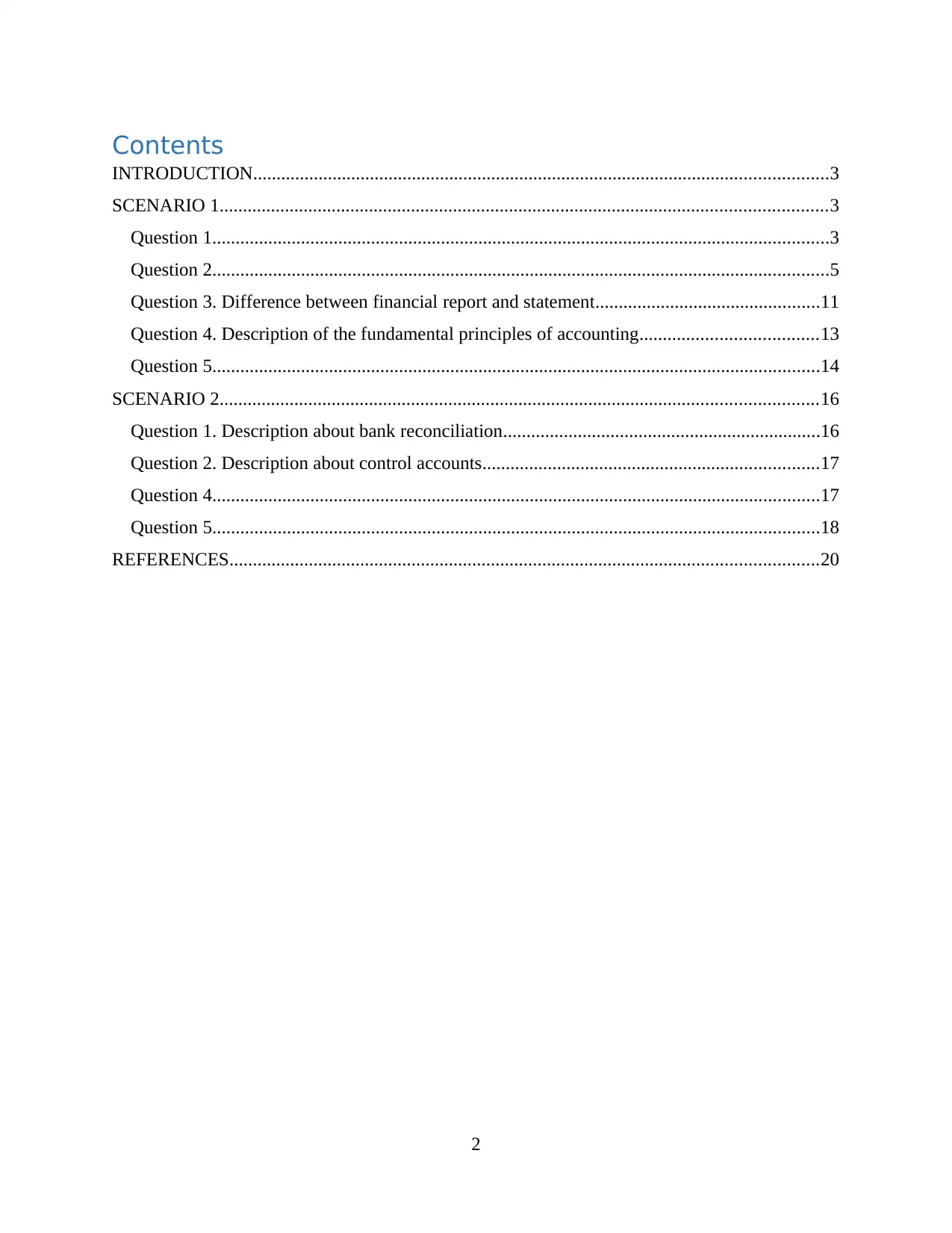
Contents
INTRODUCTION...........................................................................................................................3
SCENARIO 1..................................................................................................................................3
Question 1....................................................................................................................................3
Question 2....................................................................................................................................5
Question 3. Difference between financial report and statement................................................11
Question 4. Description of the fundamental principles of accounting......................................13
Question 5..................................................................................................................................14
SCENARIO 2................................................................................................................................16
Question 1. Description about bank reconciliation....................................................................16
Question 2. Description about control accounts........................................................................17
Question 4..................................................................................................................................17
Question 5..................................................................................................................................18
REFERENCES..............................................................................................................................20
2
INTRODUCTION...........................................................................................................................3
SCENARIO 1..................................................................................................................................3
Question 1....................................................................................................................................3
Question 2....................................................................................................................................5
Question 3. Difference between financial report and statement................................................11
Question 4. Description of the fundamental principles of accounting......................................13
Question 5..................................................................................................................................14
SCENARIO 2................................................................................................................................16
Question 1. Description about bank reconciliation....................................................................16
Question 2. Description about control accounts........................................................................17
Question 4..................................................................................................................................17
Question 5..................................................................................................................................18
REFERENCES..............................................................................................................................20
2

INTRODUCTION
Financial accounting relates to practices or processes for readying financial statements
which a corporation uses to demonstrate its financial status and efficiency to outsiders like
creditors or lenders, investors, clients and suppliers. Simply put, this is specific accounting area
that involves different processes, like recording, efficiently summarizing as well as reporting the
outcomes of fiscal transactions from business processes over specific time-frame (Suryanto and
Ridwansyah, 2016).
This study is split into two parts, each of which has specific issues. In order to complete the
first portion, some queries need to be addressed, like the kinds of transactions involving single
entry system as well as double-entry system of book keeping, trial balance as well as its
significance. The second part in such section is focused on making journal entries with respect
to each transaction, the Ledgers and a Trial Balance. The distinction between the financial
statement vs the financial report, the basic principles of the accounting and statement of income
are also key part of this portion. Section 2 is focused on preparing bank reconciliation report,
journal entries, multiple control accounts, suspense account and many other dimensions.
SCENARIO 1
Question 1
Types of business transaction
Business transactions are financial events that have taken place within a commercial entity that
could be specific in financial terms. Business transactions have financial or direct effect on the
client. There are many types of business financial transactions, almost all of which are
categorized into inner versus external transactions. These are listed as follows:
Internal business transactions: The participation of outer parties isn't always allowed in such
an transaction. These transactions have a clear effect on financial performance of corporation,
since they do not require the transfer of interests with third parties. For instance:
internal transactions involve tracking depreciation on the fixed assets and also the loss of assets
due to fire or theft etc (Schroeder, Clark and Cathey, 2019).
External business transactions: Among these transactions, the company shall exchange
cash with third parties. These are simple transactions which are carried out by the
corporation on a regular basis. For instance: external transactions involve selling of
3
Financial accounting relates to practices or processes for readying financial statements
which a corporation uses to demonstrate its financial status and efficiency to outsiders like
creditors or lenders, investors, clients and suppliers. Simply put, this is specific accounting area
that involves different processes, like recording, efficiently summarizing as well as reporting the
outcomes of fiscal transactions from business processes over specific time-frame (Suryanto and
Ridwansyah, 2016).
This study is split into two parts, each of which has specific issues. In order to complete the
first portion, some queries need to be addressed, like the kinds of transactions involving single
entry system as well as double-entry system of book keeping, trial balance as well as its
significance. The second part in such section is focused on making journal entries with respect
to each transaction, the Ledgers and a Trial Balance. The distinction between the financial
statement vs the financial report, the basic principles of the accounting and statement of income
are also key part of this portion. Section 2 is focused on preparing bank reconciliation report,
journal entries, multiple control accounts, suspense account and many other dimensions.
SCENARIO 1
Question 1
Types of business transaction
Business transactions are financial events that have taken place within a commercial entity that
could be specific in financial terms. Business transactions have financial or direct effect on the
client. There are many types of business financial transactions, almost all of which are
categorized into inner versus external transactions. These are listed as follows:
Internal business transactions: The participation of outer parties isn't always allowed in such
an transaction. These transactions have a clear effect on financial performance of corporation,
since they do not require the transfer of interests with third parties. For instance:
internal transactions involve tracking depreciation on the fixed assets and also the loss of assets
due to fire or theft etc (Schroeder, Clark and Cathey, 2019).
External business transactions: Among these transactions, the company shall exchange
cash with third parties. These are simple transactions which are carried out by the
corporation on a regular basis. For instance: external transactions involve selling of
3
You're viewing a preview
Unlock full access by subscribing today!
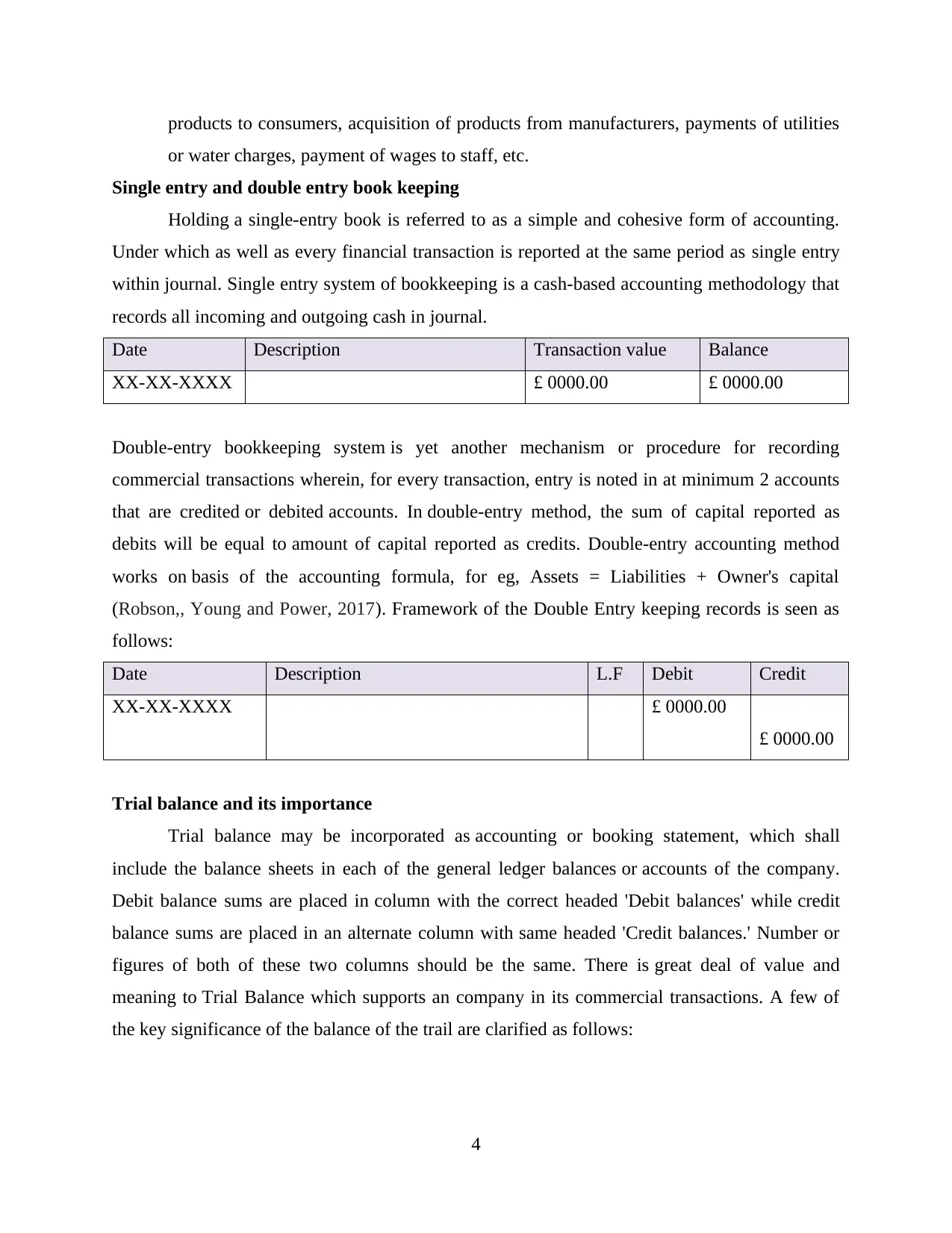
products to consumers, acquisition of products from manufacturers, payments of utilities
or water charges, payment of wages to staff, etc.
Single entry and double entry book keeping
Holding a single-entry book is referred to as a simple and cohesive form of accounting.
Under which as well as every financial transaction is reported at the same period as single entry
within journal. Single entry system of bookkeeping is a cash-based accounting methodology that
records all incoming and outgoing cash in journal.
Date Description Transaction value Balance
XX-XX-XXXX £ 0000.00 £ 0000.00
Double-entry bookkeeping system is yet another mechanism or procedure for recording
commercial transactions wherein, for every transaction, entry is noted in at minimum 2 accounts
that are credited or debited accounts. In double-entry method, the sum of capital reported as
debits will be equal to amount of capital reported as credits. Double-entry accounting method
works on basis of the accounting formula, for eg, Assets = Liabilities + Owner's capital
(Robson,, Young and Power, 2017). Framework of the Double Entry keeping records is seen as
follows:
Date Description L.F Debit Credit
XX-XX-XXXX £ 0000.00
£ 0000.00
Trial balance and its importance
Trial balance may be incorporated as accounting or booking statement, which shall
include the balance sheets in each of the general ledger balances or accounts of the company.
Debit balance sums are placed in column with the correct headed 'Debit balances' while credit
balance sums are placed in an alternate column with same headed 'Credit balances.' Number or
figures of both of these two columns should be the same. There is great deal of value and
meaning to Trial Balance which supports an company in its commercial transactions. A few of
the key significance of the balance of the trail are clarified as follows:
4
or water charges, payment of wages to staff, etc.
Single entry and double entry book keeping
Holding a single-entry book is referred to as a simple and cohesive form of accounting.
Under which as well as every financial transaction is reported at the same period as single entry
within journal. Single entry system of bookkeeping is a cash-based accounting methodology that
records all incoming and outgoing cash in journal.
Date Description Transaction value Balance
XX-XX-XXXX £ 0000.00 £ 0000.00
Double-entry bookkeeping system is yet another mechanism or procedure for recording
commercial transactions wherein, for every transaction, entry is noted in at minimum 2 accounts
that are credited or debited accounts. In double-entry method, the sum of capital reported as
debits will be equal to amount of capital reported as credits. Double-entry accounting method
works on basis of the accounting formula, for eg, Assets = Liabilities + Owner's capital
(Robson,, Young and Power, 2017). Framework of the Double Entry keeping records is seen as
follows:
Date Description L.F Debit Credit
XX-XX-XXXX £ 0000.00
£ 0000.00
Trial balance and its importance
Trial balance may be incorporated as accounting or booking statement, which shall
include the balance sheets in each of the general ledger balances or accounts of the company.
Debit balance sums are placed in column with the correct headed 'Debit balances' while credit
balance sums are placed in an alternate column with same headed 'Credit balances.' Number or
figures of both of these two columns should be the same. There is great deal of value and
meaning to Trial Balance which supports an company in its commercial transactions. A few of
the key significance of the balance of the trail are clarified as follows:
4
Paraphrase This Document
Need a fresh take? Get an instant paraphrase of this document with our AI Paraphraser
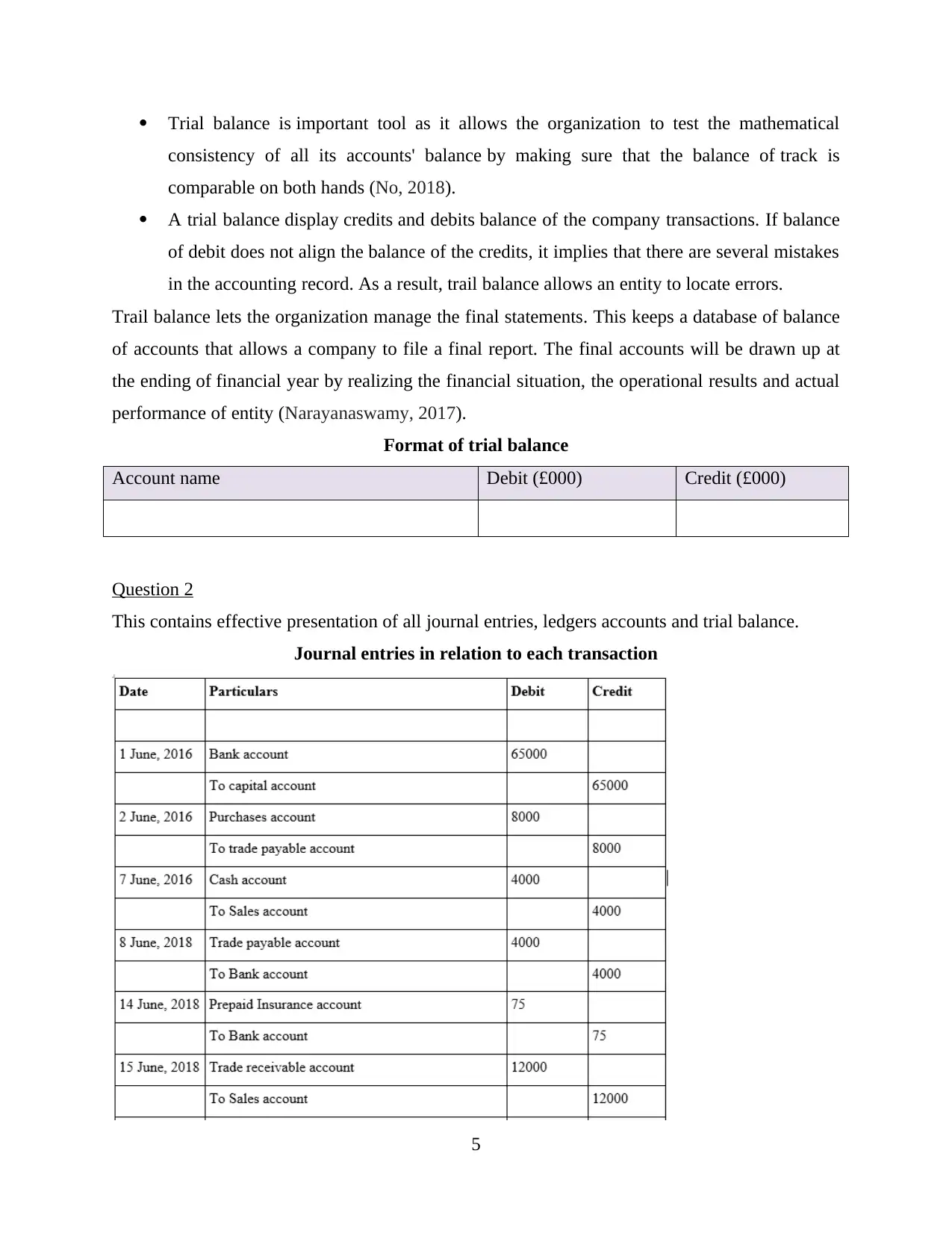
Trial balance is important tool as it allows the organization to test the mathematical
consistency of all its accounts' balance by making sure that the balance of track is
comparable on both hands (No, 2018).
A trial balance display credits and debits balance of the company transactions. If balance
of debit does not align the balance of the credits, it implies that there are several mistakes
in the accounting record. As a result, trail balance allows an entity to locate errors.
Trail balance lets the organization manage the final statements. This keeps a database of balance
of accounts that allows a company to file a final report. The final accounts will be drawn up at
the ending of financial year by realizing the financial situation, the operational results and actual
performance of entity (Narayanaswamy, 2017).
Format of trial balance
Account name Debit (£000) Credit (£000)
Question 2
This contains effective presentation of all journal entries, ledgers accounts and trial balance.
Journal entries in relation to each transaction
5
consistency of all its accounts' balance by making sure that the balance of track is
comparable on both hands (No, 2018).
A trial balance display credits and debits balance of the company transactions. If balance
of debit does not align the balance of the credits, it implies that there are several mistakes
in the accounting record. As a result, trail balance allows an entity to locate errors.
Trail balance lets the organization manage the final statements. This keeps a database of balance
of accounts that allows a company to file a final report. The final accounts will be drawn up at
the ending of financial year by realizing the financial situation, the operational results and actual
performance of entity (Narayanaswamy, 2017).
Format of trial balance
Account name Debit (£000) Credit (£000)
Question 2
This contains effective presentation of all journal entries, ledgers accounts and trial balance.
Journal entries in relation to each transaction
5
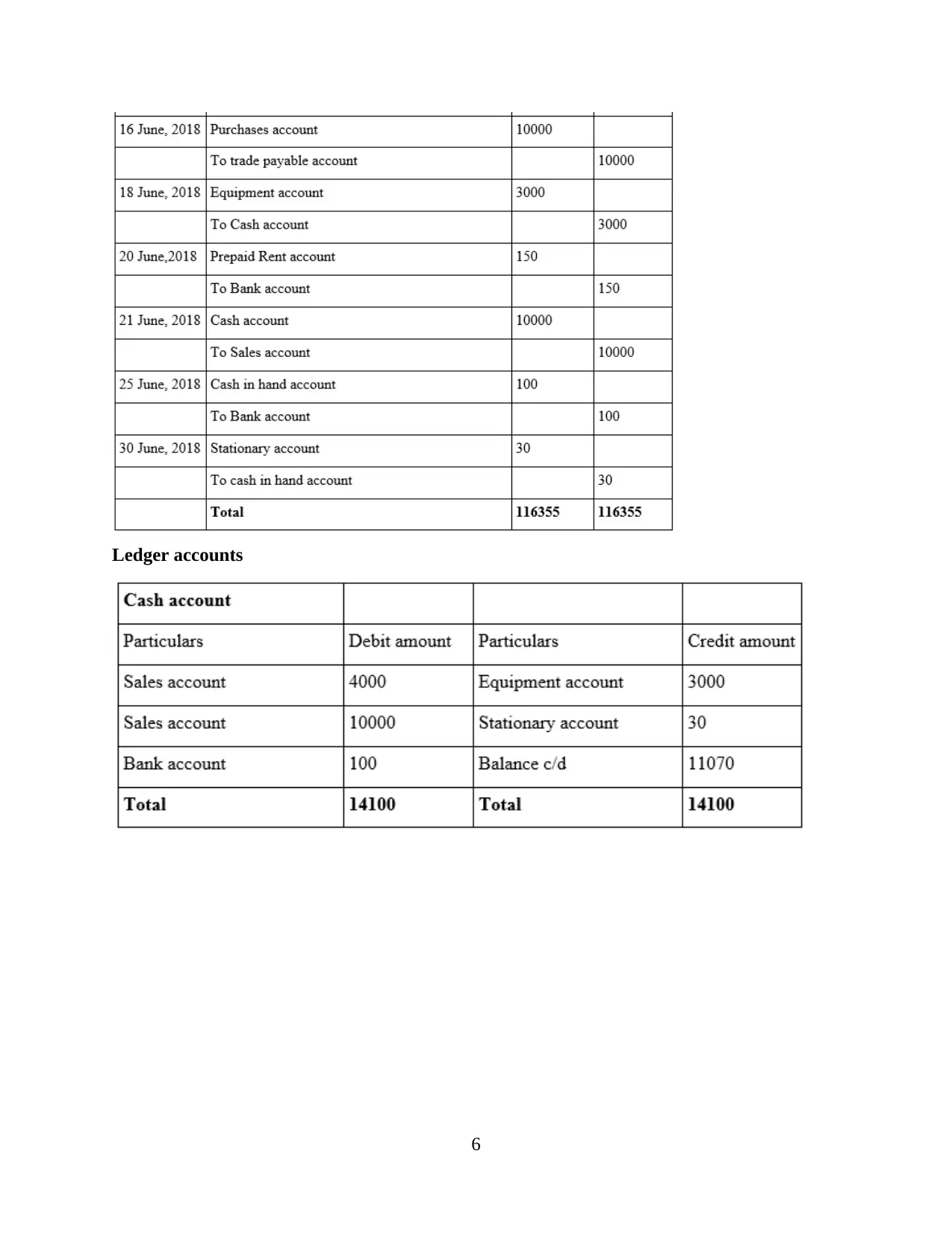
Ledger accounts
6
6
You're viewing a preview
Unlock full access by subscribing today!
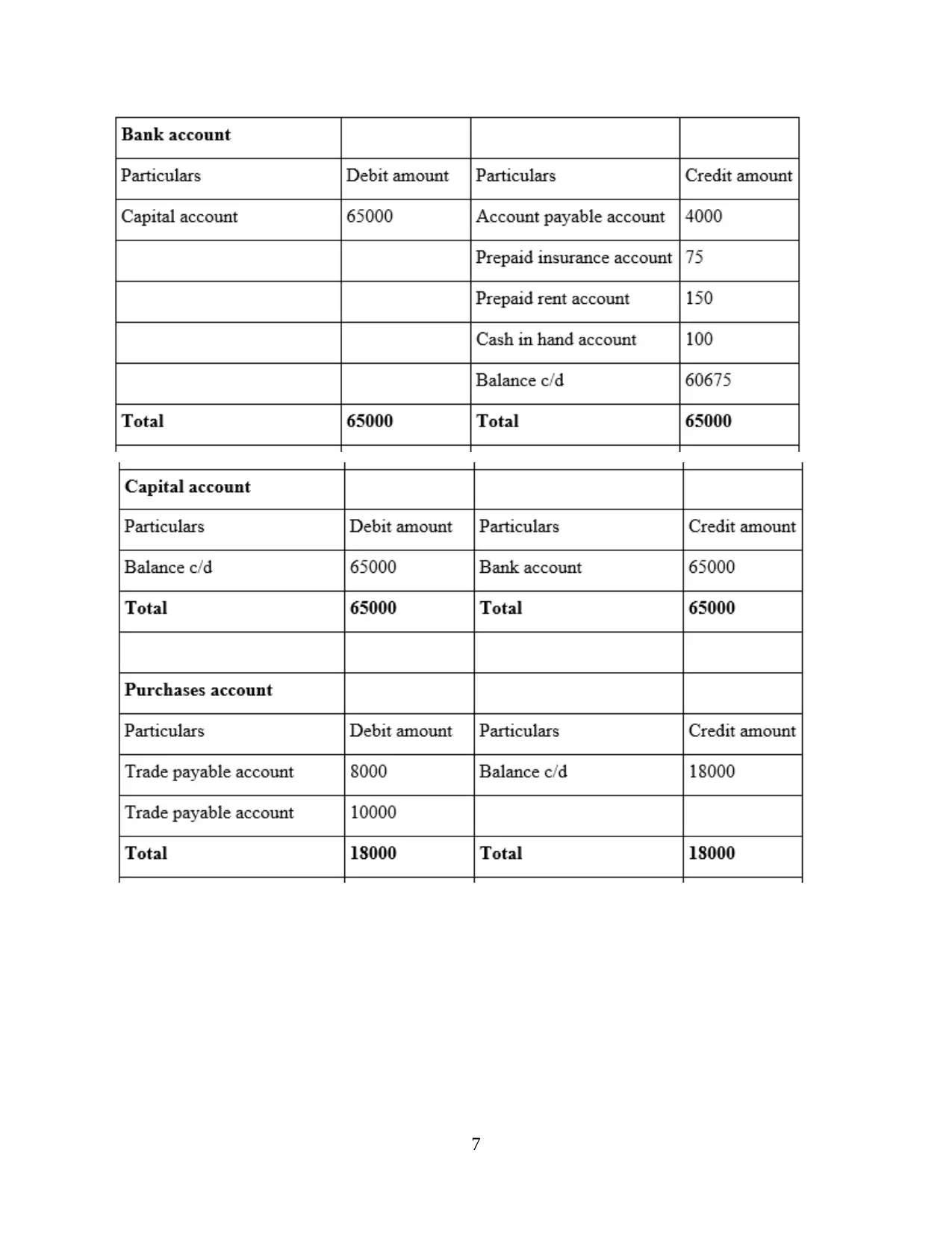
7
Paraphrase This Document
Need a fresh take? Get an instant paraphrase of this document with our AI Paraphraser
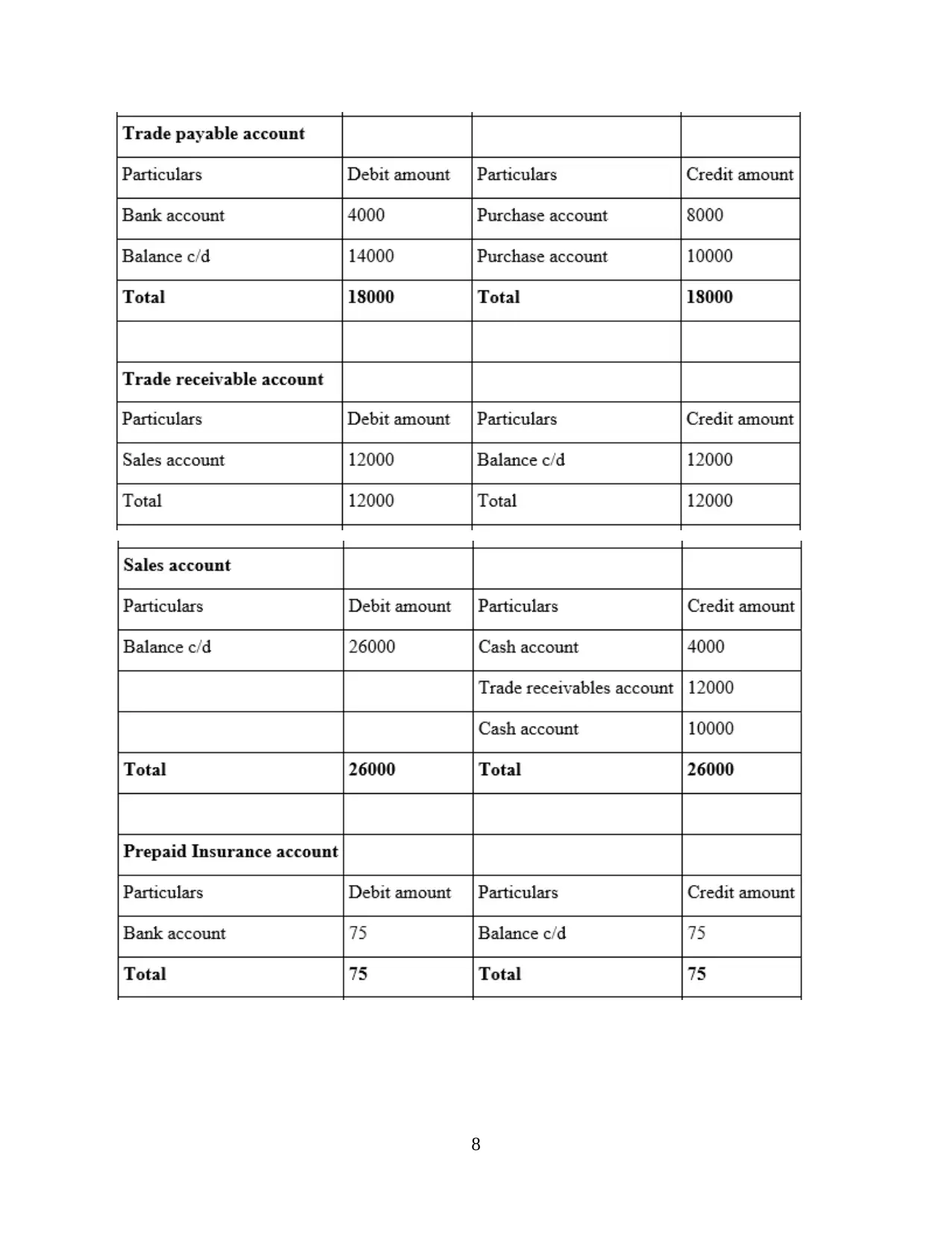
8
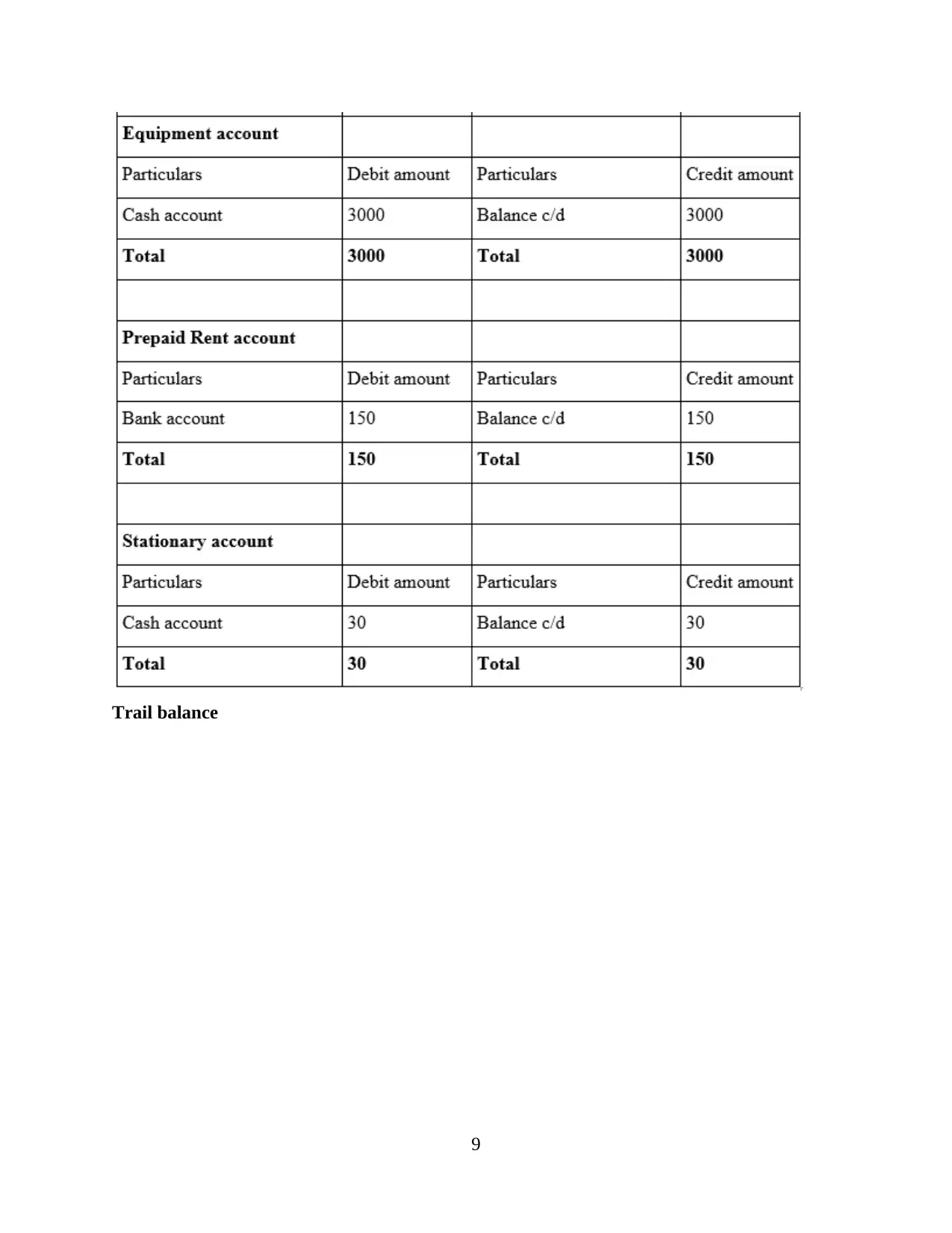
Trail balance
9
9
You're viewing a preview
Unlock full access by subscribing today!
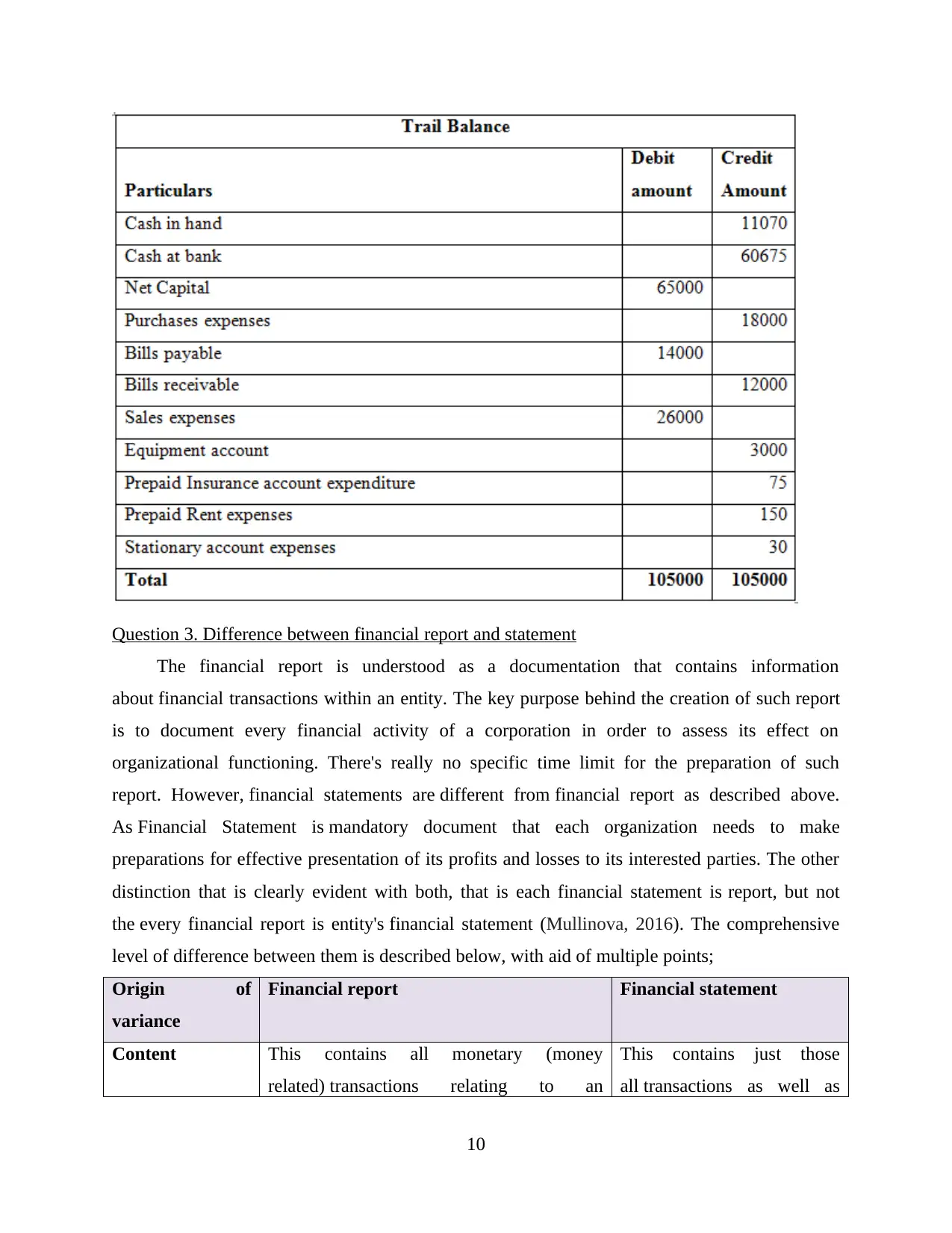
Question 3. Difference between financial report and statement
The financial report is understood as a documentation that contains information
about financial transactions within an entity. The key purpose behind the creation of such report
is to document every financial activity of a corporation in order to assess its effect on
organizational functioning. There's really no specific time limit for the preparation of such
report. However, financial statements are different from financial report as described above.
As Financial Statement is mandatory document that each organization needs to make
preparations for effective presentation of its profits and losses to its interested parties. The other
distinction that is clearly evident with both, that is each financial statement is report, but not
the every financial report is entity's financial statement (Mullinova, 2016). The comprehensive
level of difference between them is described below, with aid of multiple points;
Origin of
variance
Financial report Financial statement
Content This contains all monetary (money
related) transactions relating to an
This contains just those
all transactions as well as
10
The financial report is understood as a documentation that contains information
about financial transactions within an entity. The key purpose behind the creation of such report
is to document every financial activity of a corporation in order to assess its effect on
organizational functioning. There's really no specific time limit for the preparation of such
report. However, financial statements are different from financial report as described above.
As Financial Statement is mandatory document that each organization needs to make
preparations for effective presentation of its profits and losses to its interested parties. The other
distinction that is clearly evident with both, that is each financial statement is report, but not
the every financial report is entity's financial statement (Mullinova, 2016). The comprehensive
level of difference between them is described below, with aid of multiple points;
Origin of
variance
Financial report Financial statement
Content This contains all monetary (money
related) transactions relating to an
This contains just those
all transactions as well as
10
Paraphrase This Document
Need a fresh take? Get an instant paraphrase of this document with our AI Paraphraser
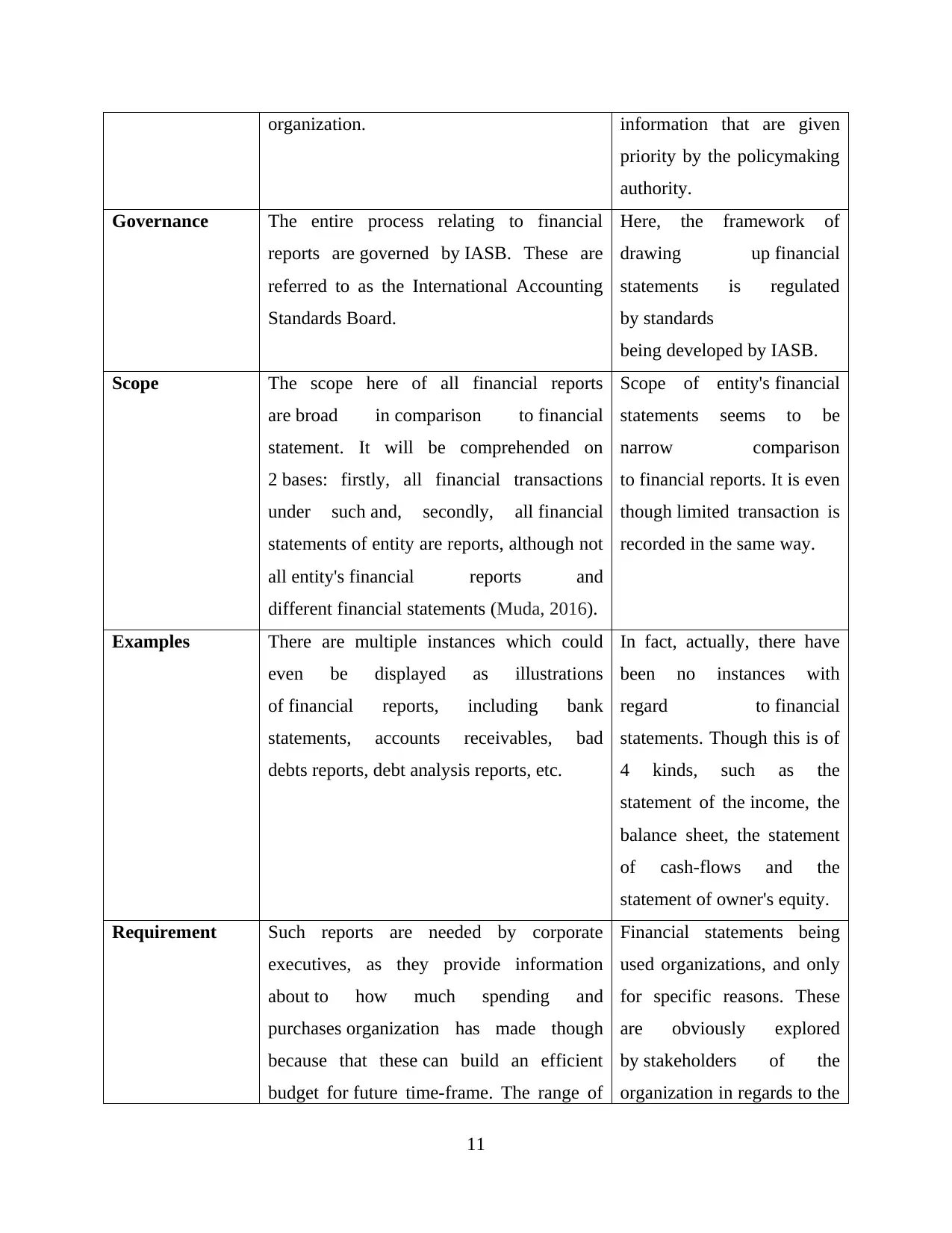
organization. information that are given
priority by the policymaking
authority.
Governance The entire process relating to financial
reports are governed by IASB. These are
referred to as the International Accounting
Standards Board.
Here, the framework of
drawing up financial
statements is regulated
by standards
being developed by IASB.
Scope The scope here of all financial reports
are broad in comparison to financial
statement. It will be comprehended on
2 bases: firstly, all financial transactions
under such and, secondly, all financial
statements of entity are reports, although not
all entity's financial reports and
different financial statements (Muda, 2016).
Scope of entity's financial
statements seems to be
narrow comparison
to financial reports. It is even
though limited transaction is
recorded in the same way.
Examples There are multiple instances which could
even be displayed as illustrations
of financial reports, including bank
statements, accounts receivables, bad
debts reports, debt analysis reports, etc.
In fact, actually, there have
been no instances with
regard to financial
statements. Though this is of
4 kinds, such as the
statement of the income, the
balance sheet, the statement
of cash-flows and the
statement of owner's equity.
Requirement Such reports are needed by corporate
executives, as they provide information
about to how much spending and
purchases organization has made though
because that these can build an efficient
budget for future time-frame. The range of
Financial statements being
used organizations, and only
for specific reasons. These
are obviously explored
by stakeholders of the
organization in regards to the
11
priority by the policymaking
authority.
Governance The entire process relating to financial
reports are governed by IASB. These are
referred to as the International Accounting
Standards Board.
Here, the framework of
drawing up financial
statements is regulated
by standards
being developed by IASB.
Scope The scope here of all financial reports
are broad in comparison to financial
statement. It will be comprehended on
2 bases: firstly, all financial transactions
under such and, secondly, all financial
statements of entity are reports, although not
all entity's financial reports and
different financial statements (Muda, 2016).
Scope of entity's financial
statements seems to be
narrow comparison
to financial reports. It is even
though limited transaction is
recorded in the same way.
Examples There are multiple instances which could
even be displayed as illustrations
of financial reports, including bank
statements, accounts receivables, bad
debts reports, debt analysis reports, etc.
In fact, actually, there have
been no instances with
regard to financial
statements. Though this is of
4 kinds, such as the
statement of the income, the
balance sheet, the statement
of cash-flows and the
statement of owner's equity.
Requirement Such reports are needed by corporate
executives, as they provide information
about to how much spending and
purchases organization has made though
because that these can build an efficient
budget for future time-frame. The range of
Financial statements being
used organizations, and only
for specific reasons. These
are obviously explored
by stakeholders of the
organization in regards to the
11

use of such reports is greater than other
because it will offer all information
regarding the organization. In addition, such
reports have also been used by
mangersin developments of financialstrateg
y that enables them to make a huge
proportion of the profits including a
decrease in sum of expenditure.
determination of financial
growth, the status, the
accessibility of cash funds
and market situation of the
firm. In addition, such
reports are often used by
outer investors when it
comes to decision-making on
financing in the organization
or not.
Users The varying no. of users commonly used in
such reports includes business management
teams, members of board and other users of
company's financial statements, as they are
also portion of entity's financial reports.
Users those who employ
financial statements widely
involve stockholders,
suppliers , lenders, creditors,
clients, public, authorities,
account receivables and
many others.
Question 4. Description of the fundamental principles of accounting
critical bookkeeping standards implies to rules that restrict and restrict business
associations whilst also producing budget reports and outlining money-related details. There’re
many different basic standards under the supervision of the business organization.
Such standards depend on measures set out in 'mostly recognized accounting gauges' as well
as 'worldwide budgetary disclosure principles.' A part of the key accounting standards involves:
Money related unit supposition: This rule states that certain budgetary exchanges that
also have taken place in a business organization should be recorded using a comparable fiscal
segment in order to ensure that understanding as well as coherence can be maintained.
Monetary substance presumption:pertaining to such a rule, a business entity must
haveits own specific identity and the initials under that it could even work together here. The
12
because it will offer all information
regarding the organization. In addition, such
reports have also been used by
mangersin developments of financialstrateg
y that enables them to make a huge
proportion of the profits including a
decrease in sum of expenditure.
determination of financial
growth, the status, the
accessibility of cash funds
and market situation of the
firm. In addition, such
reports are often used by
outer investors when it
comes to decision-making on
financing in the organization
or not.
Users The varying no. of users commonly used in
such reports includes business management
teams, members of board and other users of
company's financial statements, as they are
also portion of entity's financial reports.
Users those who employ
financial statements widely
involve stockholders,
suppliers , lenders, creditors,
clients, public, authorities,
account receivables and
many others.
Question 4. Description of the fundamental principles of accounting
critical bookkeeping standards implies to rules that restrict and restrict business
associations whilst also producing budget reports and outlining money-related details. There’re
many different basic standards under the supervision of the business organization.
Such standards depend on measures set out in 'mostly recognized accounting gauges' as well
as 'worldwide budgetary disclosure principles.' A part of the key accounting standards involves:
Money related unit supposition: This rule states that certain budgetary exchanges that
also have taken place in a business organization should be recorded using a comparable fiscal
segment in order to ensure that understanding as well as coherence can be maintained.
Monetary substance presumption:pertaining to such a rule, a business entity must
haveits own specific identity and the initials under that it could even work together here. The
12
You're viewing a preview
Unlock full access by subscribing today!
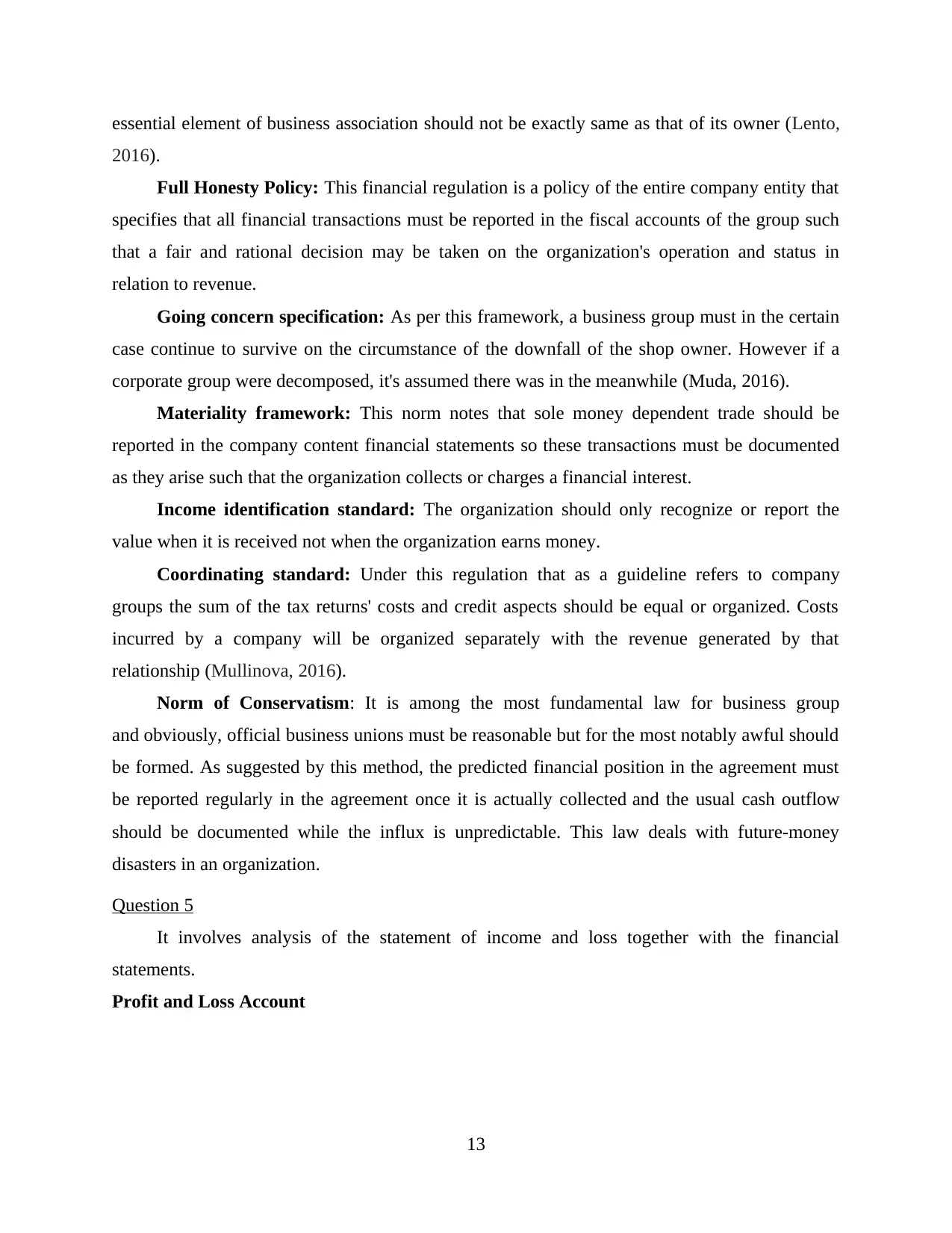
essential element of business association should not be exactly same as that of its owner (Lento,
2016).
Full Honesty Policy: This financial regulation is a policy of the entire company entity that
specifies that all financial transactions must be reported in the fiscal accounts of the group such
that a fair and rational decision may be taken on the organization's operation and status in
relation to revenue.
Going concern specification: As per this framework, a business group must in the certain
case continue to survive on the circumstance of the downfall of the shop owner. However if a
corporate group were decomposed, it's assumed there was in the meanwhile (Muda, 2016).
Materiality framework: This norm notes that sole money dependent trade should be
reported in the company content financial statements so these transactions must be documented
as they arise such that the organization collects or charges a financial interest.
Income identification standard: The organization should only recognize or report the
value when it is received not when the organization earns money.
Coordinating standard: Under this regulation that as a guideline refers to company
groups the sum of the tax returns' costs and credit aspects should be equal or organized. Costs
incurred by a company will be organized separately with the revenue generated by that
relationship (Mullinova, 2016).
Norm of Conservatism: It is among the most fundamental law for business group
and obviously, official business unions must be reasonable but for the most notably awful should
be formed. As suggested by this method, the predicted financial position in the agreement must
be reported regularly in the agreement once it is actually collected and the usual cash outflow
should be documented while the influx is unpredictable. This law deals with future-money
disasters in an organization.
Question 5
It involves analysis of the statement of income and loss together with the financial
statements.
Profit and Loss Account
13
2016).
Full Honesty Policy: This financial regulation is a policy of the entire company entity that
specifies that all financial transactions must be reported in the fiscal accounts of the group such
that a fair and rational decision may be taken on the organization's operation and status in
relation to revenue.
Going concern specification: As per this framework, a business group must in the certain
case continue to survive on the circumstance of the downfall of the shop owner. However if a
corporate group were decomposed, it's assumed there was in the meanwhile (Muda, 2016).
Materiality framework: This norm notes that sole money dependent trade should be
reported in the company content financial statements so these transactions must be documented
as they arise such that the organization collects or charges a financial interest.
Income identification standard: The organization should only recognize or report the
value when it is received not when the organization earns money.
Coordinating standard: Under this regulation that as a guideline refers to company
groups the sum of the tax returns' costs and credit aspects should be equal or organized. Costs
incurred by a company will be organized separately with the revenue generated by that
relationship (Mullinova, 2016).
Norm of Conservatism: It is among the most fundamental law for business group
and obviously, official business unions must be reasonable but for the most notably awful should
be formed. As suggested by this method, the predicted financial position in the agreement must
be reported regularly in the agreement once it is actually collected and the usual cash outflow
should be documented while the influx is unpredictable. This law deals with future-money
disasters in an organization.
Question 5
It involves analysis of the statement of income and loss together with the financial
statements.
Profit and Loss Account
13
Paraphrase This Document
Need a fresh take? Get an instant paraphrase of this document with our AI Paraphraser
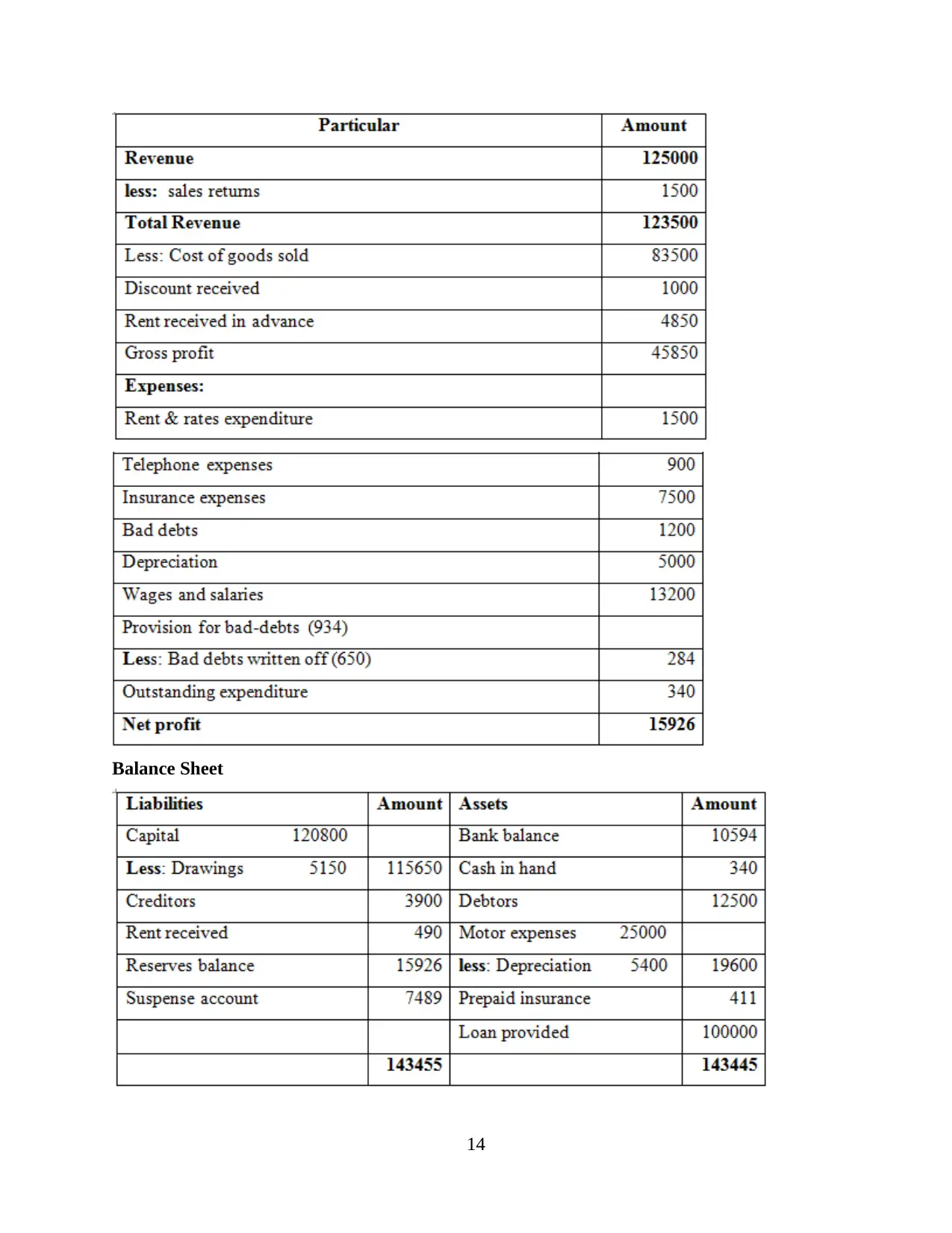
Balance Sheet
14
14
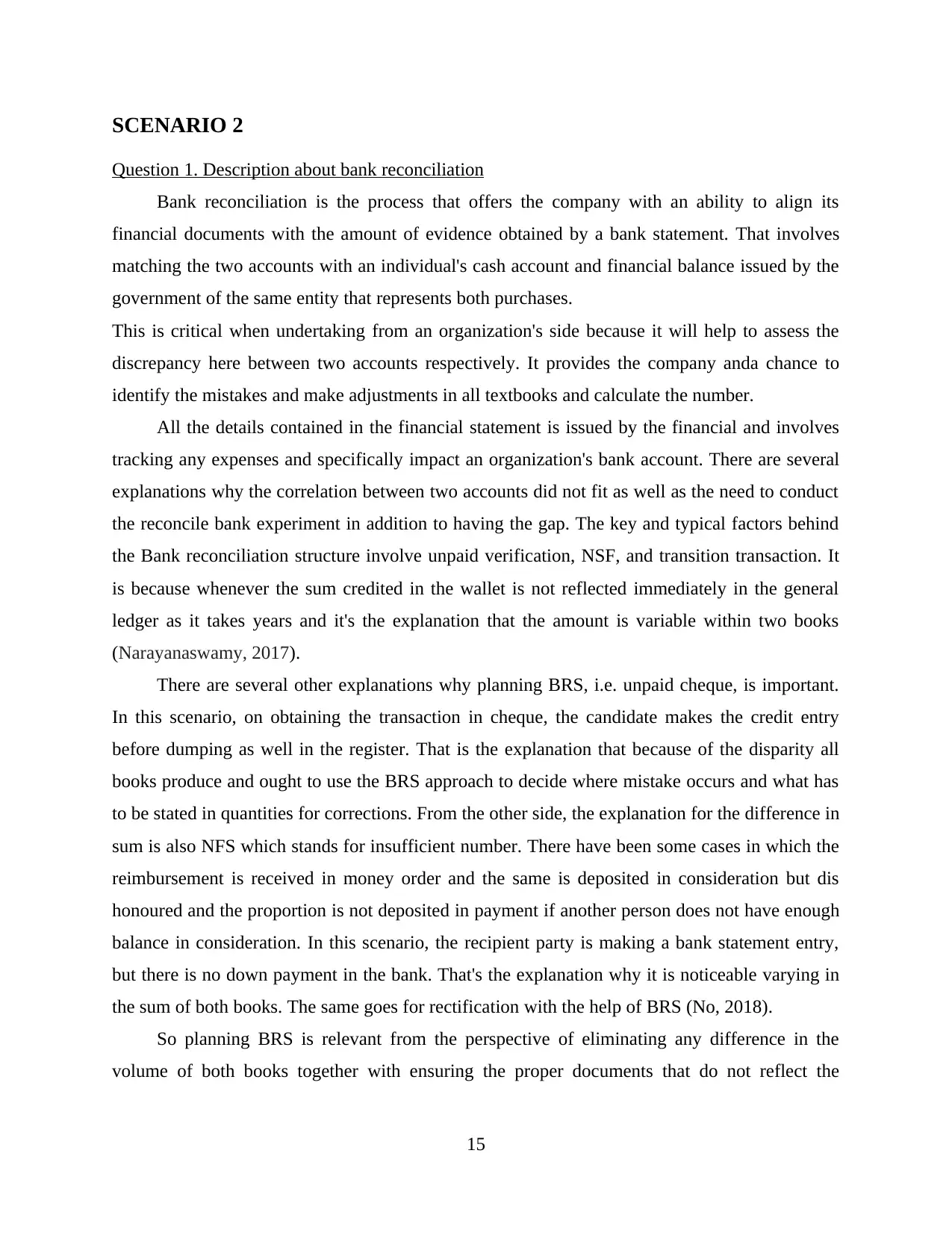
SCENARIO 2
Question 1. Description about bank reconciliation
Bank reconciliation is the process that offers the company with an ability to align its
financial documents with the amount of evidence obtained by a bank statement. That involves
matching the two accounts with an individual's cash account and financial balance issued by the
government of the same entity that represents both purchases.
This is critical when undertaking from an organization's side because it will help to assess the
discrepancy here between two accounts respectively. It provides the company anda chance to
identify the mistakes and make adjustments in all textbooks and calculate the number.
All the details contained in the financial statement is issued by the financial and involves
tracking any expenses and specifically impact an organization's bank account. There are several
explanations why the correlation between two accounts did not fit as well as the need to conduct
the reconcile bank experiment in addition to having the gap. The key and typical factors behind
the Bank reconciliation structure involve unpaid verification, NSF, and transition transaction. It
is because whenever the sum credited in the wallet is not reflected immediately in the general
ledger as it takes years and it's the explanation that the amount is variable within two books
(Narayanaswamy, 2017).
There are several other explanations why planning BRS, i.e. unpaid cheque, is important.
In this scenario, on obtaining the transaction in cheque, the candidate makes the credit entry
before dumping as well in the register. That is the explanation that because of the disparity all
books produce and ought to use the BRS approach to decide where mistake occurs and what has
to be stated in quantities for corrections. From the other side, the explanation for the difference in
sum is also NFS which stands for insufficient number. There have been some cases in which the
reimbursement is received in money order and the same is deposited in consideration but dis
honoured and the proportion is not deposited in payment if another person does not have enough
balance in consideration. In this scenario, the recipient party is making a bank statement entry,
but there is no down payment in the bank. That's the explanation why it is noticeable varying in
the sum of both books. The same goes for rectification with the help of BRS (No, 2018).
So planning BRS is relevant from the perspective of eliminating any difference in the
volume of both books together with ensuring the proper documents that do not reflect the
15
Question 1. Description about bank reconciliation
Bank reconciliation is the process that offers the company with an ability to align its
financial documents with the amount of evidence obtained by a bank statement. That involves
matching the two accounts with an individual's cash account and financial balance issued by the
government of the same entity that represents both purchases.
This is critical when undertaking from an organization's side because it will help to assess the
discrepancy here between two accounts respectively. It provides the company anda chance to
identify the mistakes and make adjustments in all textbooks and calculate the number.
All the details contained in the financial statement is issued by the financial and involves
tracking any expenses and specifically impact an organization's bank account. There are several
explanations why the correlation between two accounts did not fit as well as the need to conduct
the reconcile bank experiment in addition to having the gap. The key and typical factors behind
the Bank reconciliation structure involve unpaid verification, NSF, and transition transaction. It
is because whenever the sum credited in the wallet is not reflected immediately in the general
ledger as it takes years and it's the explanation that the amount is variable within two books
(Narayanaswamy, 2017).
There are several other explanations why planning BRS, i.e. unpaid cheque, is important.
In this scenario, on obtaining the transaction in cheque, the candidate makes the credit entry
before dumping as well in the register. That is the explanation that because of the disparity all
books produce and ought to use the BRS approach to decide where mistake occurs and what has
to be stated in quantities for corrections. From the other side, the explanation for the difference in
sum is also NFS which stands for insufficient number. There have been some cases in which the
reimbursement is received in money order and the same is deposited in consideration but dis
honoured and the proportion is not deposited in payment if another person does not have enough
balance in consideration. In this scenario, the recipient party is making a bank statement entry,
but there is no down payment in the bank. That's the explanation why it is noticeable varying in
the sum of both books. The same goes for rectification with the help of BRS (No, 2018).
So planning BRS is relevant from the perspective of eliminating any difference in the
volume of both books together with ensuring the proper documents that do not reflect the
15
You're viewing a preview
Unlock full access by subscribing today!
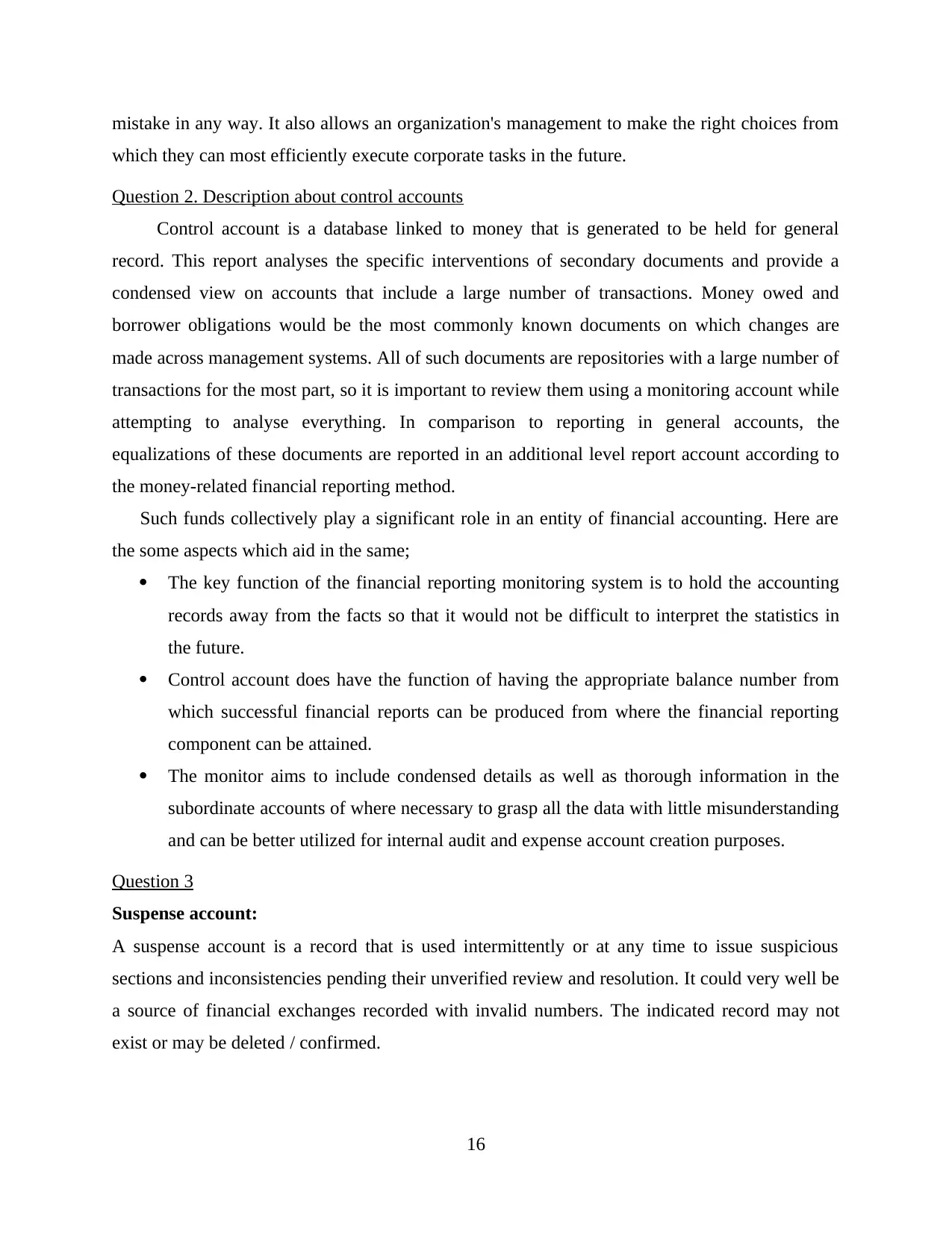
mistake in any way. It also allows an organization's management to make the right choices from
which they can most efficiently execute corporate tasks in the future.
Question 2. Description about control accounts
Control account is a database linked to money that is generated to be held for general
record. This report analyses the specific interventions of secondary documents and provide a
condensed view on accounts that include a large number of transactions. Money owed and
borrower obligations would be the most commonly known documents on which changes are
made across management systems. All of such documents are repositories with a large number of
transactions for the most part, so it is important to review them using a monitoring account while
attempting to analyse everything. In comparison to reporting in general accounts, the
equalizations of these documents are reported in an additional level report account according to
the money-related financial reporting method.
Such funds collectively play a significant role in an entity of financial accounting. Here are
the some aspects which aid in the same;
The key function of the financial reporting monitoring system is to hold the accounting
records away from the facts so that it would not be difficult to interpret the statistics in
the future.
Control account does have the function of having the appropriate balance number from
which successful financial reports can be produced from where the financial reporting
component can be attained.
The monitor aims to include condensed details as well as thorough information in the
subordinate accounts of where necessary to grasp all the data with little misunderstanding
and can be better utilized for internal audit and expense account creation purposes.
Question 3
Suspense account:
A suspense account is a record that is used intermittently or at any time to issue suspicious
sections and inconsistencies pending their unverified review and resolution. It could very well be
a source of financial exchanges recorded with invalid numbers. The indicated record may not
exist or may be deleted / confirmed.
16
which they can most efficiently execute corporate tasks in the future.
Question 2. Description about control accounts
Control account is a database linked to money that is generated to be held for general
record. This report analyses the specific interventions of secondary documents and provide a
condensed view on accounts that include a large number of transactions. Money owed and
borrower obligations would be the most commonly known documents on which changes are
made across management systems. All of such documents are repositories with a large number of
transactions for the most part, so it is important to review them using a monitoring account while
attempting to analyse everything. In comparison to reporting in general accounts, the
equalizations of these documents are reported in an additional level report account according to
the money-related financial reporting method.
Such funds collectively play a significant role in an entity of financial accounting. Here are
the some aspects which aid in the same;
The key function of the financial reporting monitoring system is to hold the accounting
records away from the facts so that it would not be difficult to interpret the statistics in
the future.
Control account does have the function of having the appropriate balance number from
which successful financial reports can be produced from where the financial reporting
component can be attained.
The monitor aims to include condensed details as well as thorough information in the
subordinate accounts of where necessary to grasp all the data with little misunderstanding
and can be better utilized for internal audit and expense account creation purposes.
Question 3
Suspense account:
A suspense account is a record that is used intermittently or at any time to issue suspicious
sections and inconsistencies pending their unverified review and resolution. It could very well be
a source of financial exchanges recorded with invalid numbers. The indicated record may not
exist or may be deleted / confirmed.
16
Paraphrase This Document
Need a fresh take? Get an instant paraphrase of this document with our AI Paraphraser
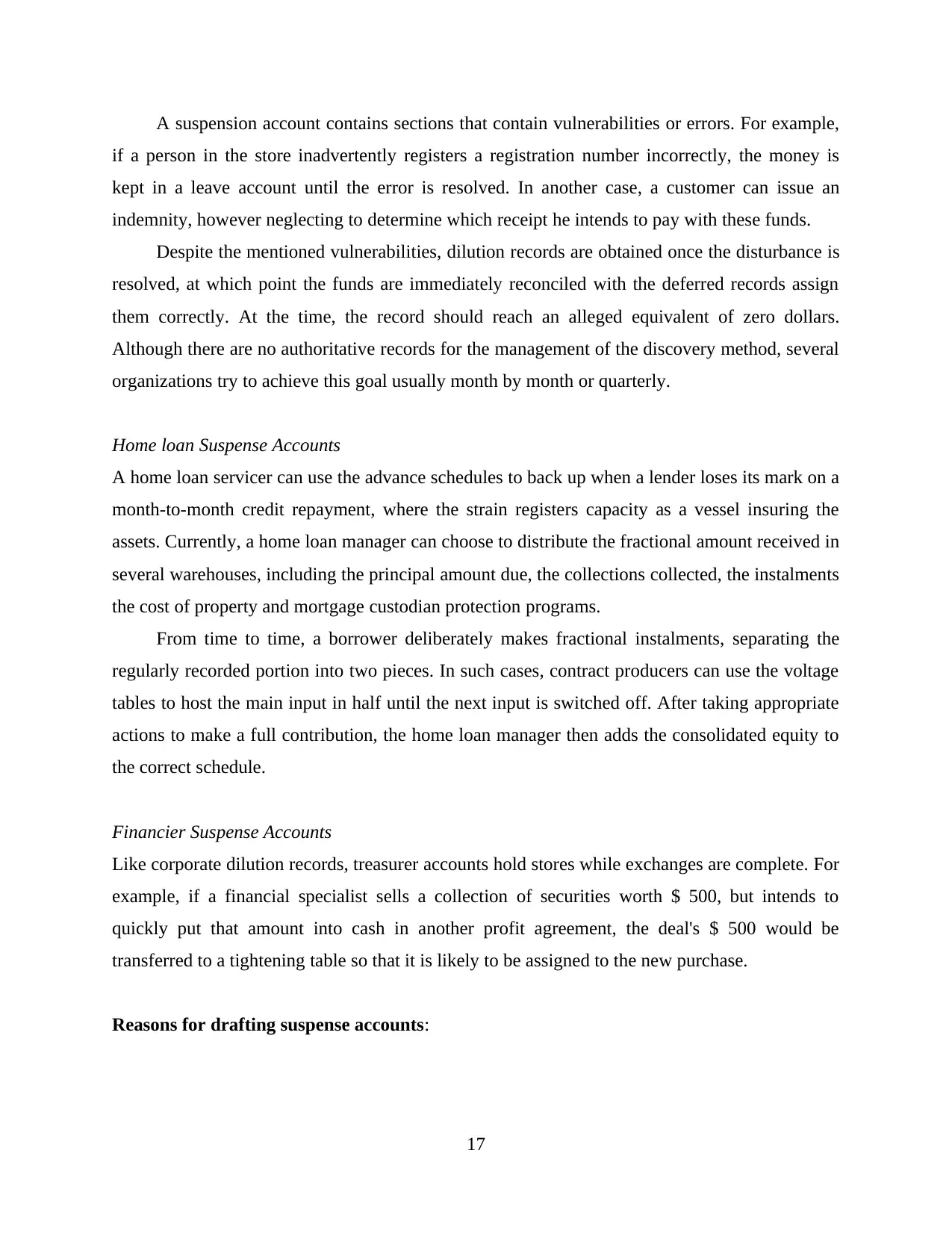
A suspension account contains sections that contain vulnerabilities or errors. For example,
if a person in the store inadvertently registers a registration number incorrectly, the money is
kept in a leave account until the error is resolved. In another case, a customer can issue an
indemnity, however neglecting to determine which receipt he intends to pay with these funds.
Despite the mentioned vulnerabilities, dilution records are obtained once the disturbance is
resolved, at which point the funds are immediately reconciled with the deferred records assign
them correctly. At the time, the record should reach an alleged equivalent of zero dollars.
Although there are no authoritative records for the management of the discovery method, several
organizations try to achieve this goal usually month by month or quarterly.
Home loan Suspense Accounts
A home loan servicer can use the advance schedules to back up when a lender loses its mark on a
month-to-month credit repayment, where the strain registers capacity as a vessel insuring the
assets. Currently, a home loan manager can choose to distribute the fractional amount received in
several warehouses, including the principal amount due, the collections collected, the instalments
the cost of property and mortgage custodian protection programs.
From time to time, a borrower deliberately makes fractional instalments, separating the
regularly recorded portion into two pieces. In such cases, contract producers can use the voltage
tables to host the main input in half until the next input is switched off. After taking appropriate
actions to make a full contribution, the home loan manager then adds the consolidated equity to
the correct schedule.
Financier Suspense Accounts
Like corporate dilution records, treasurer accounts hold stores while exchanges are complete. For
example, if a financial specialist sells a collection of securities worth $ 500, but intends to
quickly put that amount into cash in another profit agreement, the deal's $ 500 would be
transferred to a tightening table so that it is likely to be assigned to the new purchase.
Reasons for drafting suspense accounts:
17
if a person in the store inadvertently registers a registration number incorrectly, the money is
kept in a leave account until the error is resolved. In another case, a customer can issue an
indemnity, however neglecting to determine which receipt he intends to pay with these funds.
Despite the mentioned vulnerabilities, dilution records are obtained once the disturbance is
resolved, at which point the funds are immediately reconciled with the deferred records assign
them correctly. At the time, the record should reach an alleged equivalent of zero dollars.
Although there are no authoritative records for the management of the discovery method, several
organizations try to achieve this goal usually month by month or quarterly.
Home loan Suspense Accounts
A home loan servicer can use the advance schedules to back up when a lender loses its mark on a
month-to-month credit repayment, where the strain registers capacity as a vessel insuring the
assets. Currently, a home loan manager can choose to distribute the fractional amount received in
several warehouses, including the principal amount due, the collections collected, the instalments
the cost of property and mortgage custodian protection programs.
From time to time, a borrower deliberately makes fractional instalments, separating the
regularly recorded portion into two pieces. In such cases, contract producers can use the voltage
tables to host the main input in half until the next input is switched off. After taking appropriate
actions to make a full contribution, the home loan manager then adds the consolidated equity to
the correct schedule.
Financier Suspense Accounts
Like corporate dilution records, treasurer accounts hold stores while exchanges are complete. For
example, if a financial specialist sells a collection of securities worth $ 500, but intends to
quickly put that amount into cash in another profit agreement, the deal's $ 500 would be
transferred to a tightening table so that it is likely to be assigned to the new purchase.
Reasons for drafting suspense accounts:
17
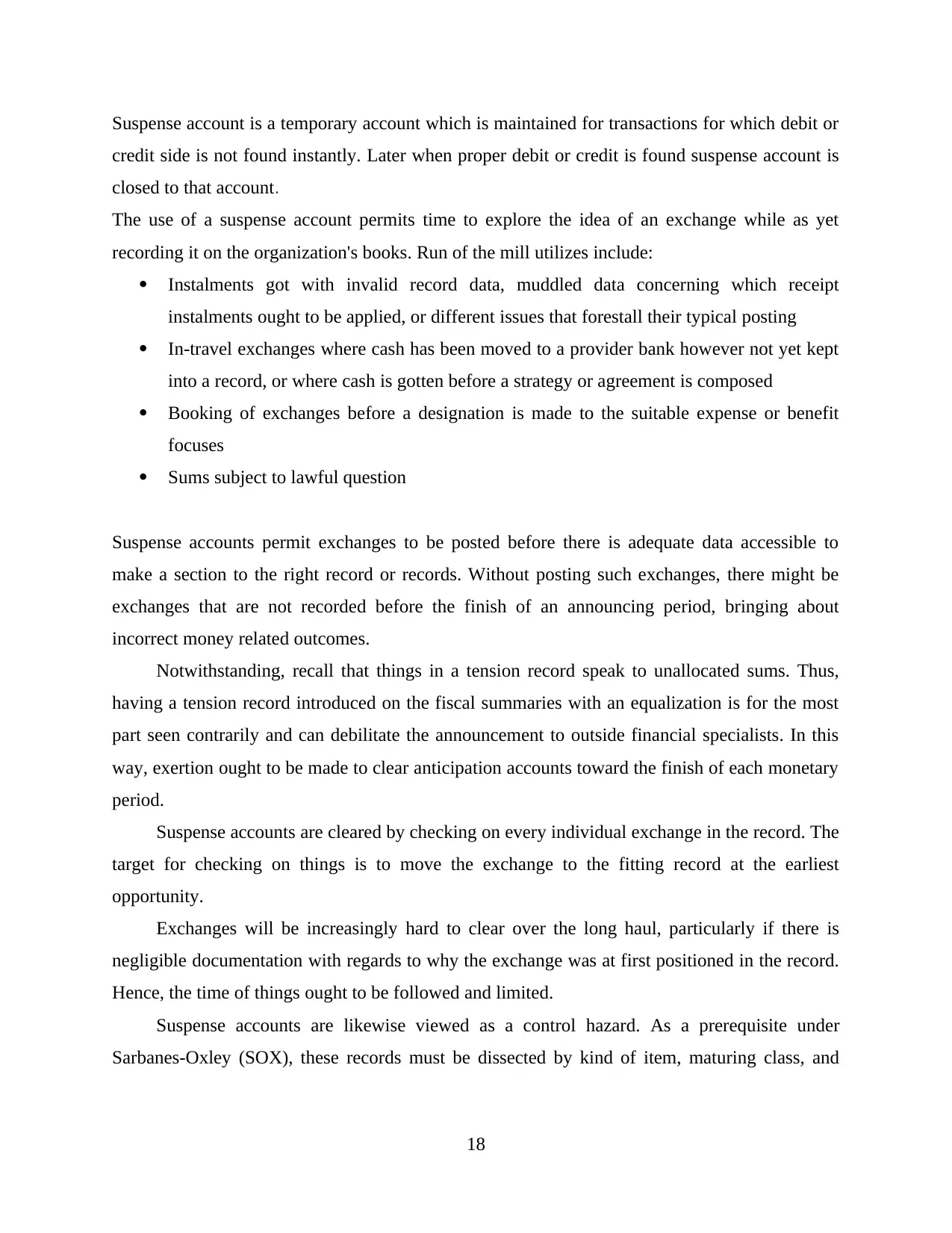
Suspense account is a temporary account which is maintained for transactions for which debit or
credit side is not found instantly. Later when proper debit or credit is found suspense account is
closed to that account.
The use of a suspense account permits time to explore the idea of an exchange while as yet
recording it on the organization's books. Run of the mill utilizes include:
Instalments got with invalid record data, muddled data concerning which receipt
instalments ought to be applied, or different issues that forestall their typical posting
In-travel exchanges where cash has been moved to a provider bank however not yet kept
into a record, or where cash is gotten before a strategy or agreement is composed
Booking of exchanges before a designation is made to the suitable expense or benefit
focuses
Sums subject to lawful question
Suspense accounts permit exchanges to be posted before there is adequate data accessible to
make a section to the right record or records. Without posting such exchanges, there might be
exchanges that are not recorded before the finish of an announcing period, bringing about
incorrect money related outcomes.
Notwithstanding, recall that things in a tension record speak to unallocated sums. Thus,
having a tension record introduced on the fiscal summaries with an equalization is for the most
part seen contrarily and can debilitate the announcement to outside financial specialists. In this
way, exertion ought to be made to clear anticipation accounts toward the finish of each monetary
period.
Suspense accounts are cleared by checking on every individual exchange in the record. The
target for checking on things is to move the exchange to the fitting record at the earliest
opportunity.
Exchanges will be increasingly hard to clear over the long haul, particularly if there is
negligible documentation with regards to why the exchange was at first positioned in the record.
Hence, the time of things ought to be followed and limited.
Suspense accounts are likewise viewed as a control hazard. As a prerequisite under
Sarbanes-Oxley (SOX), these records must be dissected by kind of item, maturing class, and
18
credit side is not found instantly. Later when proper debit or credit is found suspense account is
closed to that account.
The use of a suspense account permits time to explore the idea of an exchange while as yet
recording it on the organization's books. Run of the mill utilizes include:
Instalments got with invalid record data, muddled data concerning which receipt
instalments ought to be applied, or different issues that forestall their typical posting
In-travel exchanges where cash has been moved to a provider bank however not yet kept
into a record, or where cash is gotten before a strategy or agreement is composed
Booking of exchanges before a designation is made to the suitable expense or benefit
focuses
Sums subject to lawful question
Suspense accounts permit exchanges to be posted before there is adequate data accessible to
make a section to the right record or records. Without posting such exchanges, there might be
exchanges that are not recorded before the finish of an announcing period, bringing about
incorrect money related outcomes.
Notwithstanding, recall that things in a tension record speak to unallocated sums. Thus,
having a tension record introduced on the fiscal summaries with an equalization is for the most
part seen contrarily and can debilitate the announcement to outside financial specialists. In this
way, exertion ought to be made to clear anticipation accounts toward the finish of each monetary
period.
Suspense accounts are cleared by checking on every individual exchange in the record. The
target for checking on things is to move the exchange to the fitting record at the earliest
opportunity.
Exchanges will be increasingly hard to clear over the long haul, particularly if there is
negligible documentation with regards to why the exchange was at first positioned in the record.
Hence, the time of things ought to be followed and limited.
Suspense accounts are likewise viewed as a control hazard. As a prerequisite under
Sarbanes-Oxley (SOX), these records must be dissected by kind of item, maturing class, and
18
You're viewing a preview
Unlock full access by subscribing today!
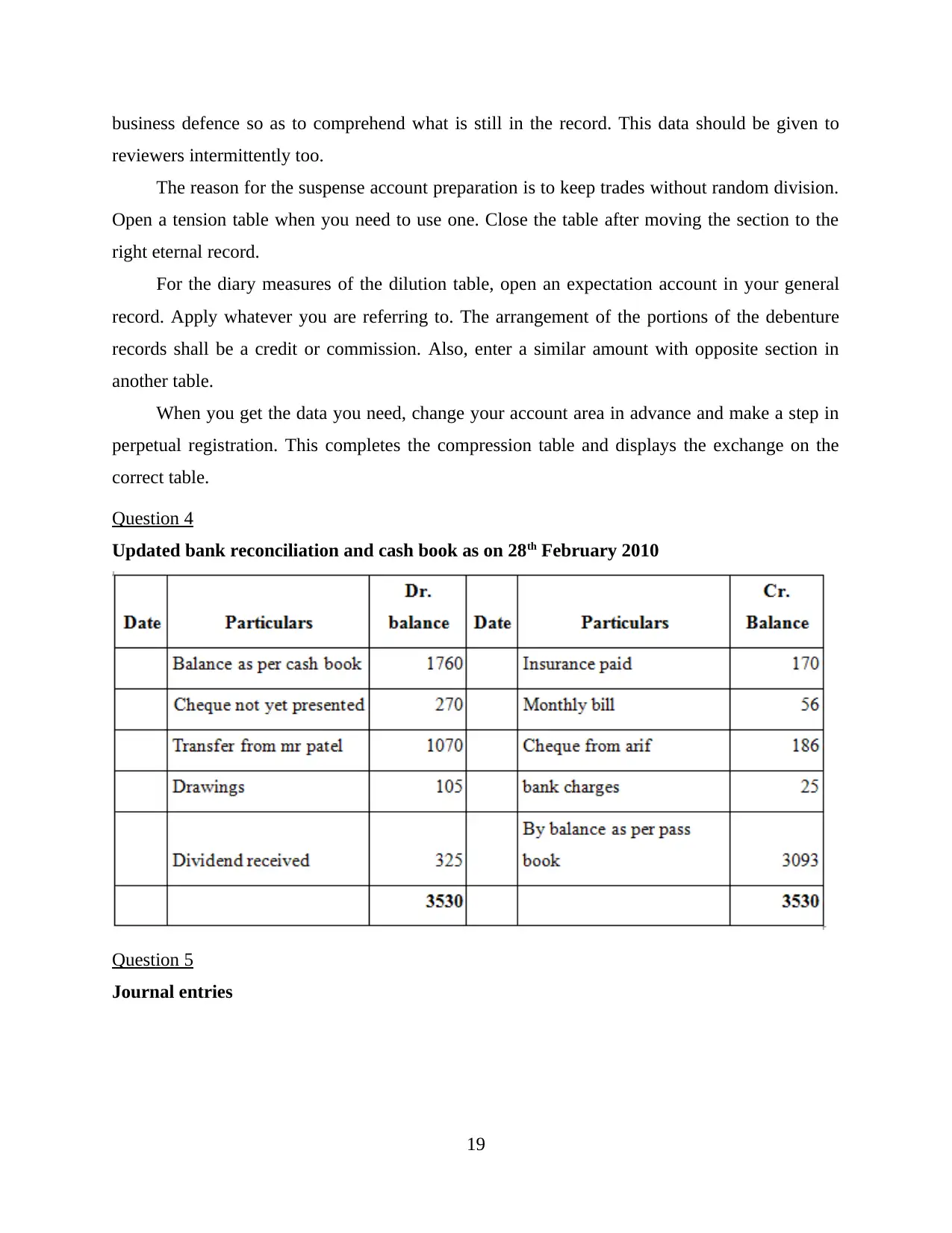
business defence so as to comprehend what is still in the record. This data should be given to
reviewers intermittently too.
The reason for the suspense account preparation is to keep trades without random division.
Open a tension table when you need to use one. Close the table after moving the section to the
right eternal record.
For the diary measures of the dilution table, open an expectation account in your general
record. Apply whatever you are referring to. The arrangement of the portions of the debenture
records shall be a credit or commission. Also, enter a similar amount with opposite section in
another table.
When you get the data you need, change your account area in advance and make a step in
perpetual registration. This completes the compression table and displays the exchange on the
correct table.
Question 4
Updated bank reconciliation and cash book as on 28th February 2010
Question 5
Journal entries
19
reviewers intermittently too.
The reason for the suspense account preparation is to keep trades without random division.
Open a tension table when you need to use one. Close the table after moving the section to the
right eternal record.
For the diary measures of the dilution table, open an expectation account in your general
record. Apply whatever you are referring to. The arrangement of the portions of the debenture
records shall be a credit or commission. Also, enter a similar amount with opposite section in
another table.
When you get the data you need, change your account area in advance and make a step in
perpetual registration. This completes the compression table and displays the exchange on the
correct table.
Question 4
Updated bank reconciliation and cash book as on 28th February 2010
Question 5
Journal entries
19
Paraphrase This Document
Need a fresh take? Get an instant paraphrase of this document with our AI Paraphraser
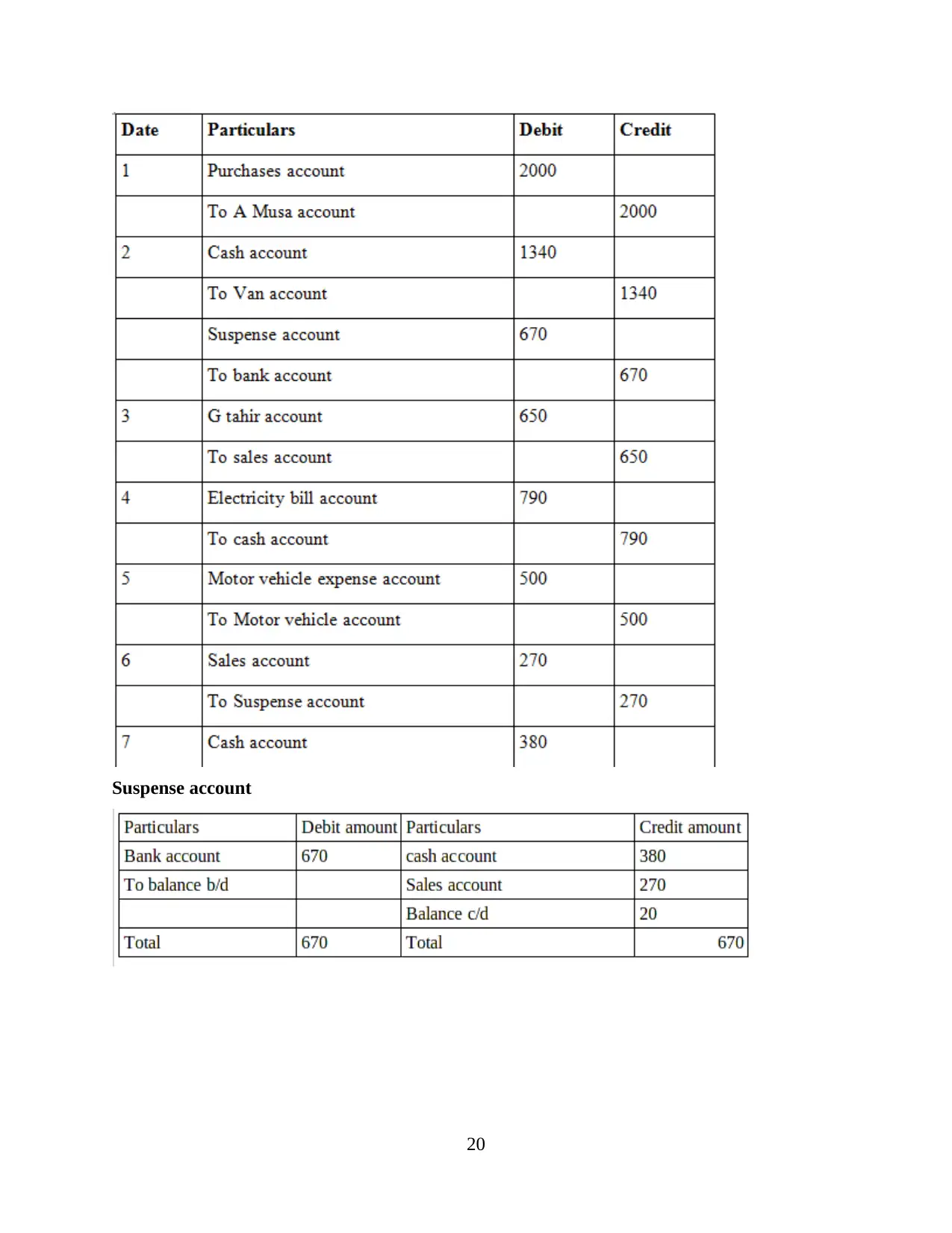
Suspense account
20
20
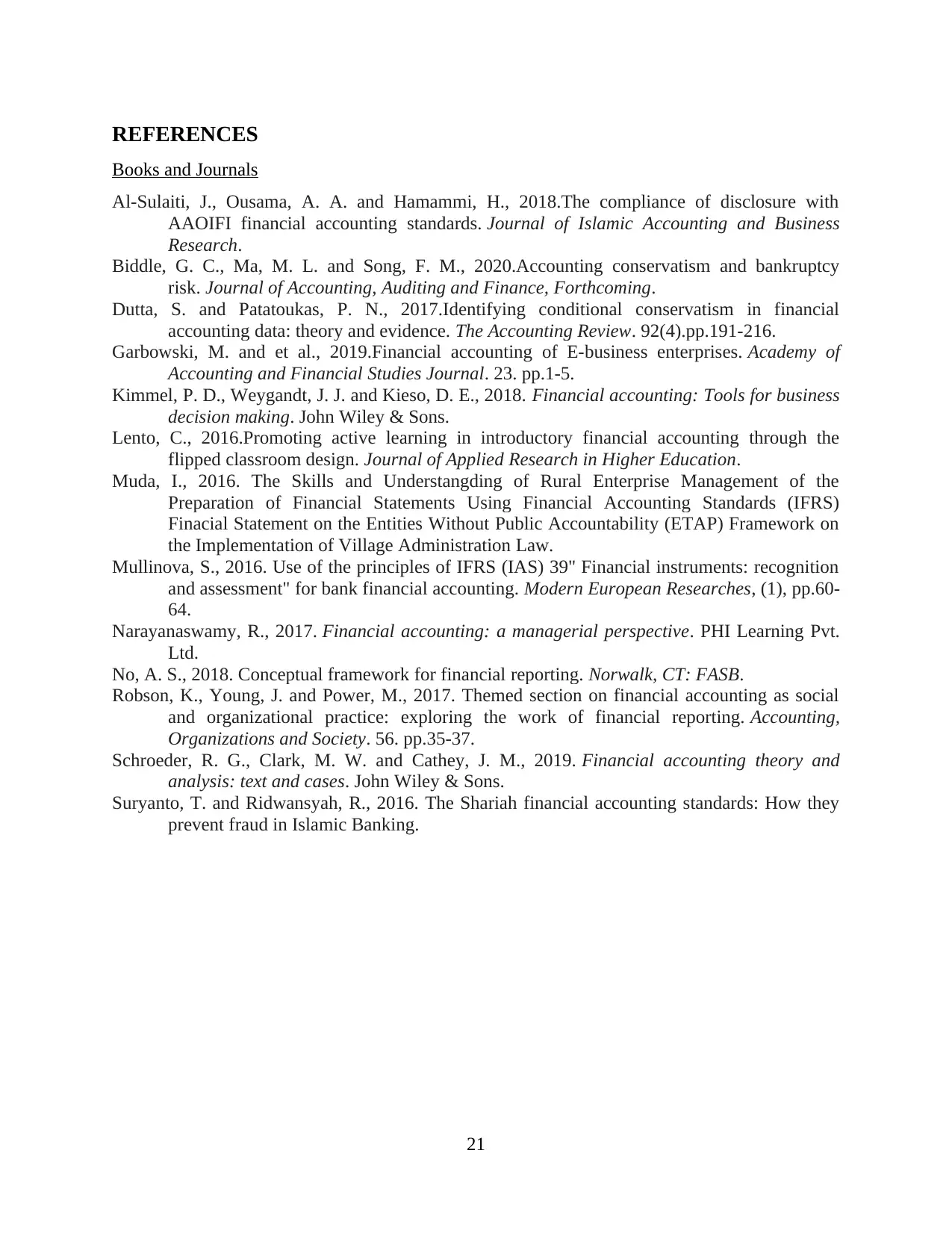
REFERENCES
Books and Journals
Al-Sulaiti, J., Ousama, A. A. and Hamammi, H., 2018.The compliance of disclosure with
AAOIFI financial accounting standards. Journal of Islamic Accounting and Business
Research.
Biddle, G. C., Ma, M. L. and Song, F. M., 2020.Accounting conservatism and bankruptcy
risk. Journal of Accounting, Auditing and Finance, Forthcoming.
Dutta, S. and Patatoukas, P. N., 2017.Identifying conditional conservatism in financial
accounting data: theory and evidence. The Accounting Review. 92(4).pp.191-216.
Garbowski, M. and et al., 2019.Financial accounting of E-business enterprises. Academy of
Accounting and Financial Studies Journal. 23. pp.1-5.
Kimmel, P. D., Weygandt, J. J. and Kieso, D. E., 2018. Financial accounting: Tools for business
decision making. John Wiley & Sons.
Lento, C., 2016.Promoting active learning in introductory financial accounting through the
flipped classroom design. Journal of Applied Research in Higher Education.
Muda, I., 2016. The Skills and Understangding of Rural Enterprise Management of the
Preparation of Financial Statements Using Financial Accounting Standards (IFRS)
Finacial Statement on the Entities Without Public Accountability (ETAP) Framework on
the Implementation of Village Administration Law.
Mullinova, S., 2016. Use of the principles of IFRS (IAS) 39" Financial instruments: recognition
and assessment" for bank financial accounting. Modern European Researches, (1), pp.60-
64.
Narayanaswamy, R., 2017. Financial accounting: a managerial perspective. PHI Learning Pvt.
Ltd.
No, A. S., 2018. Conceptual framework for financial reporting. Norwalk, CT: FASB.
Robson, K., Young, J. and Power, M., 2017. Themed section on financial accounting as social
and organizational practice: exploring the work of financial reporting. Accounting,
Organizations and Society. 56. pp.35-37.
Schroeder, R. G., Clark, M. W. and Cathey, J. M., 2019. Financial accounting theory and
analysis: text and cases. John Wiley & Sons.
Suryanto, T. and Ridwansyah, R., 2016. The Shariah financial accounting standards: How they
prevent fraud in Islamic Banking.
21
Books and Journals
Al-Sulaiti, J., Ousama, A. A. and Hamammi, H., 2018.The compliance of disclosure with
AAOIFI financial accounting standards. Journal of Islamic Accounting and Business
Research.
Biddle, G. C., Ma, M. L. and Song, F. M., 2020.Accounting conservatism and bankruptcy
risk. Journal of Accounting, Auditing and Finance, Forthcoming.
Dutta, S. and Patatoukas, P. N., 2017.Identifying conditional conservatism in financial
accounting data: theory and evidence. The Accounting Review. 92(4).pp.191-216.
Garbowski, M. and et al., 2019.Financial accounting of E-business enterprises. Academy of
Accounting and Financial Studies Journal. 23. pp.1-5.
Kimmel, P. D., Weygandt, J. J. and Kieso, D. E., 2018. Financial accounting: Tools for business
decision making. John Wiley & Sons.
Lento, C., 2016.Promoting active learning in introductory financial accounting through the
flipped classroom design. Journal of Applied Research in Higher Education.
Muda, I., 2016. The Skills and Understangding of Rural Enterprise Management of the
Preparation of Financial Statements Using Financial Accounting Standards (IFRS)
Finacial Statement on the Entities Without Public Accountability (ETAP) Framework on
the Implementation of Village Administration Law.
Mullinova, S., 2016. Use of the principles of IFRS (IAS) 39" Financial instruments: recognition
and assessment" for bank financial accounting. Modern European Researches, (1), pp.60-
64.
Narayanaswamy, R., 2017. Financial accounting: a managerial perspective. PHI Learning Pvt.
Ltd.
No, A. S., 2018. Conceptual framework for financial reporting. Norwalk, CT: FASB.
Robson, K., Young, J. and Power, M., 2017. Themed section on financial accounting as social
and organizational practice: exploring the work of financial reporting. Accounting,
Organizations and Society. 56. pp.35-37.
Schroeder, R. G., Clark, M. W. and Cathey, J. M., 2019. Financial accounting theory and
analysis: text and cases. John Wiley & Sons.
Suryanto, T. and Ridwansyah, R., 2016. The Shariah financial accounting standards: How they
prevent fraud in Islamic Banking.
21
You're viewing a preview
Unlock full access by subscribing today!
1 out of 21
Related Documents
Your All-in-One AI-Powered Toolkit for Academic Success.
+13062052269
info@desklib.com
Available 24*7 on WhatsApp / Email
![[object Object]](/_next/static/media/star-bottom.7253800d.svg)
Unlock your academic potential
© 2024 | Zucol Services PVT LTD | All rights reserved.





